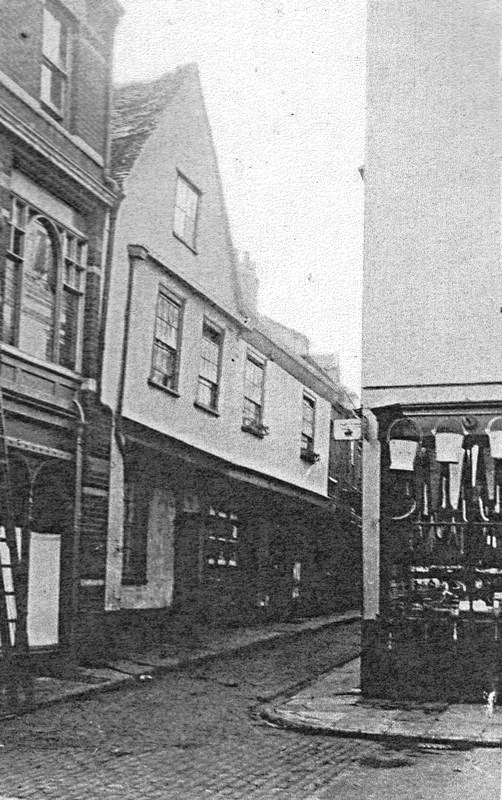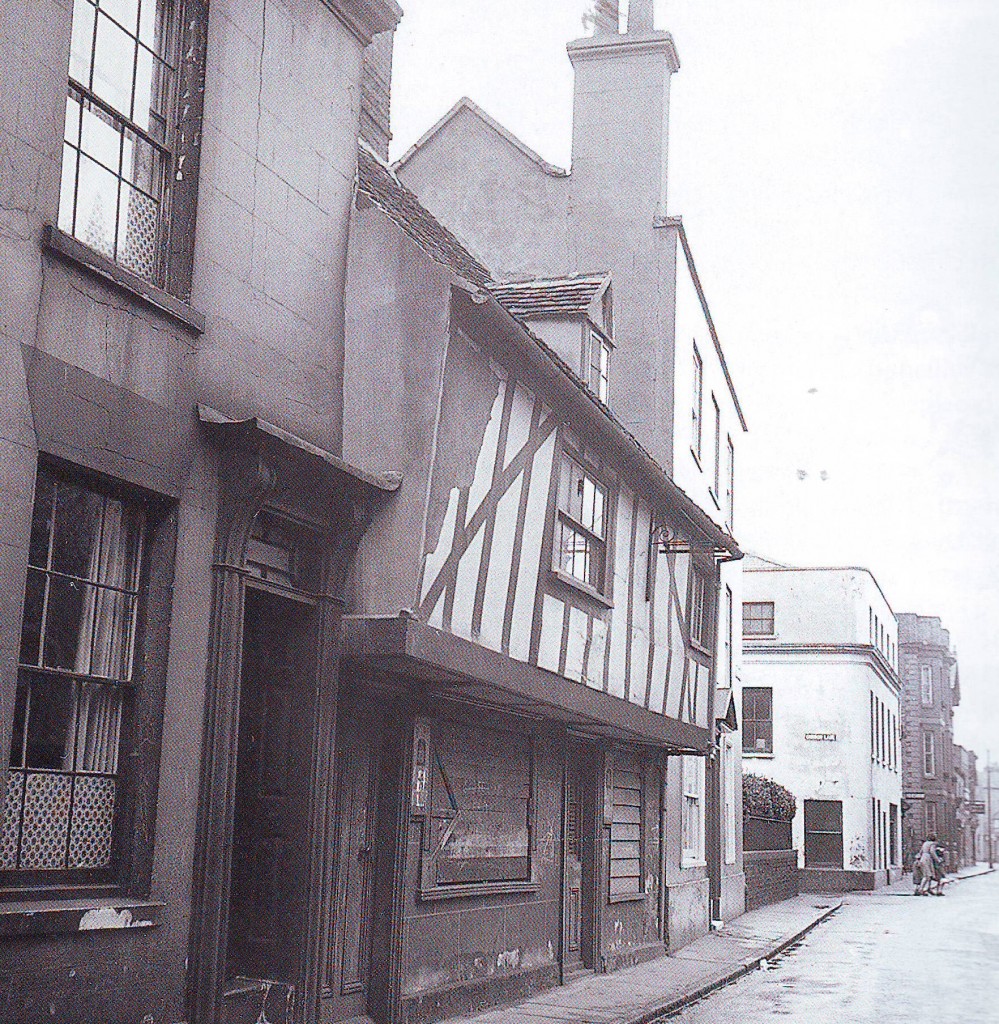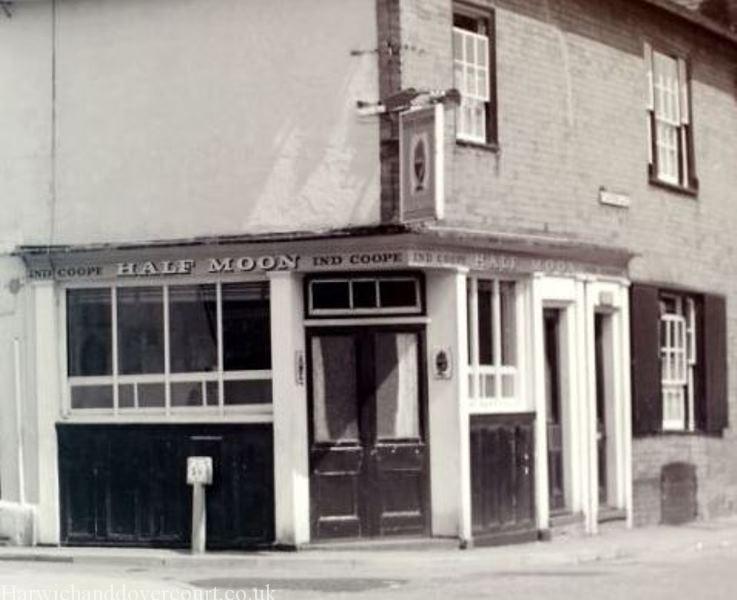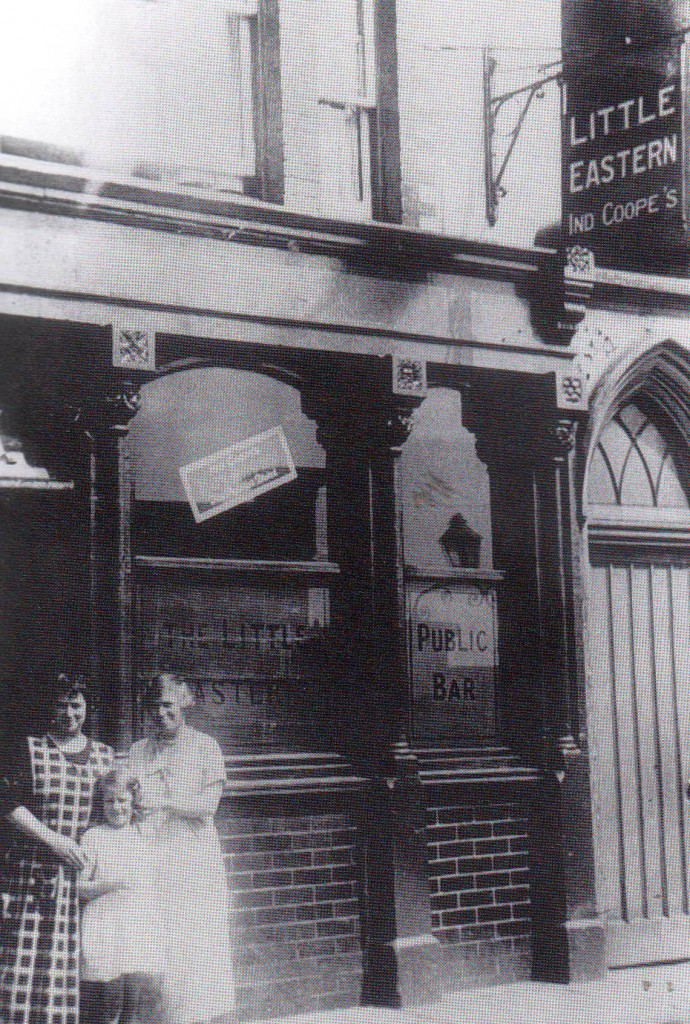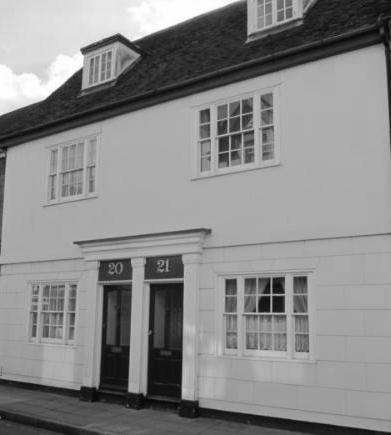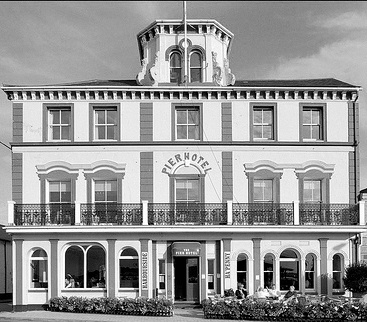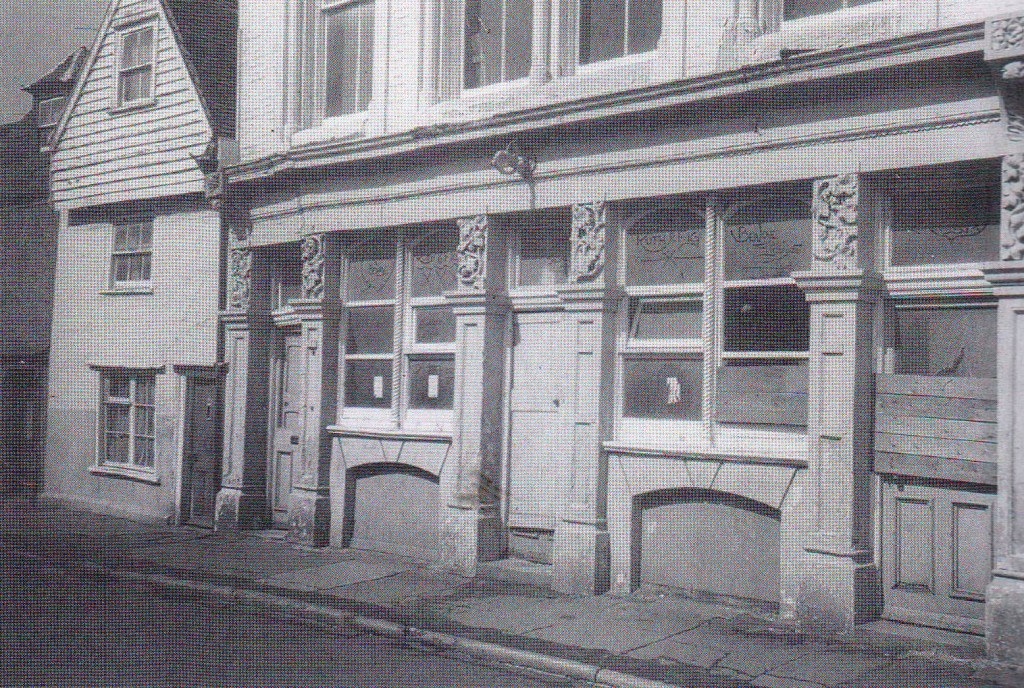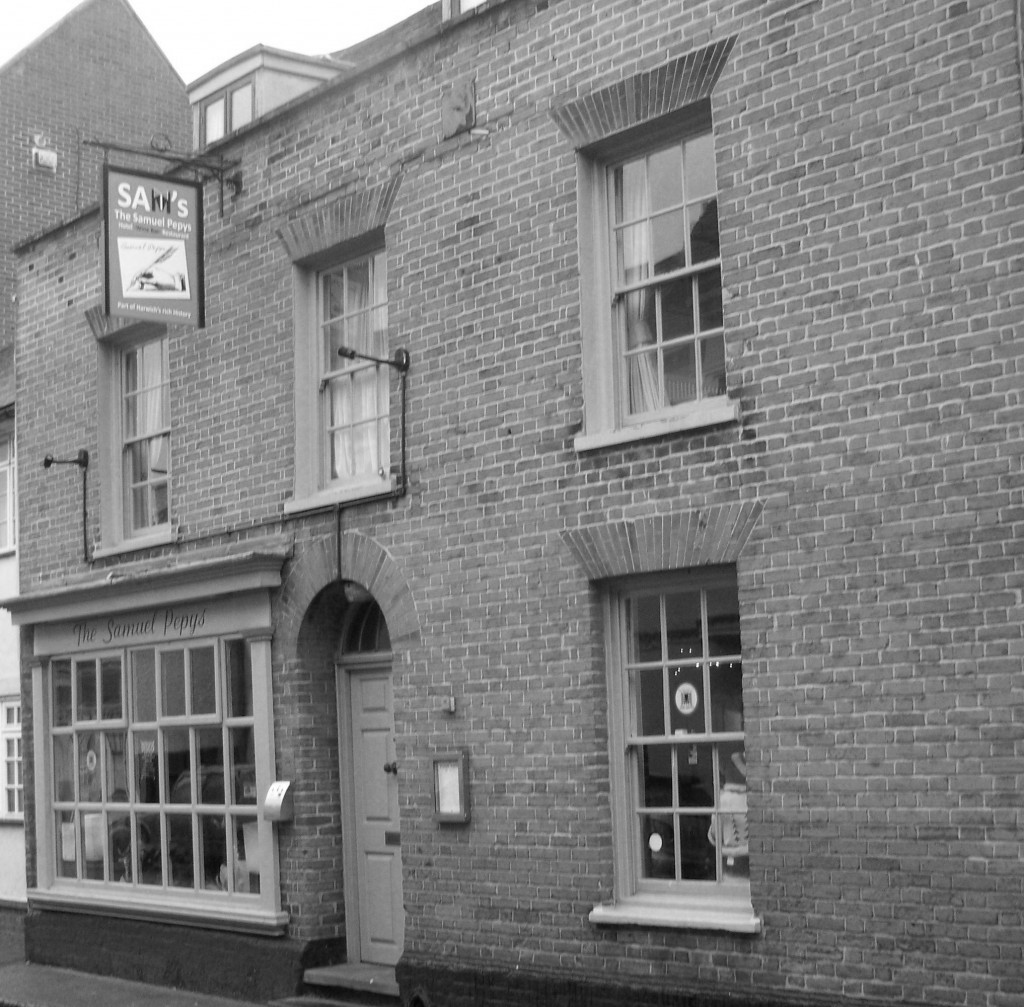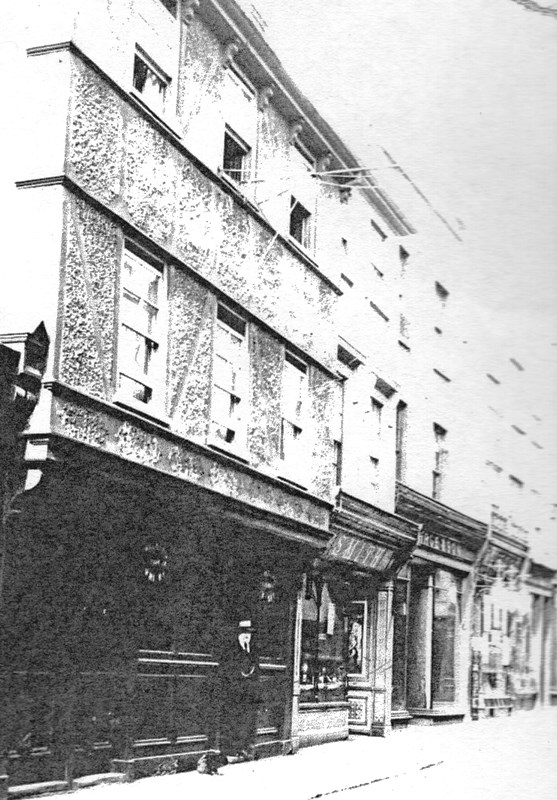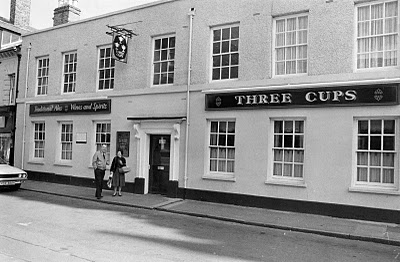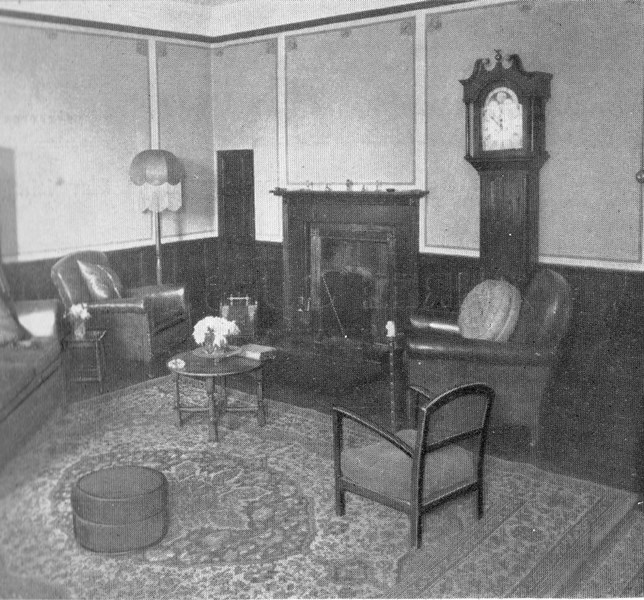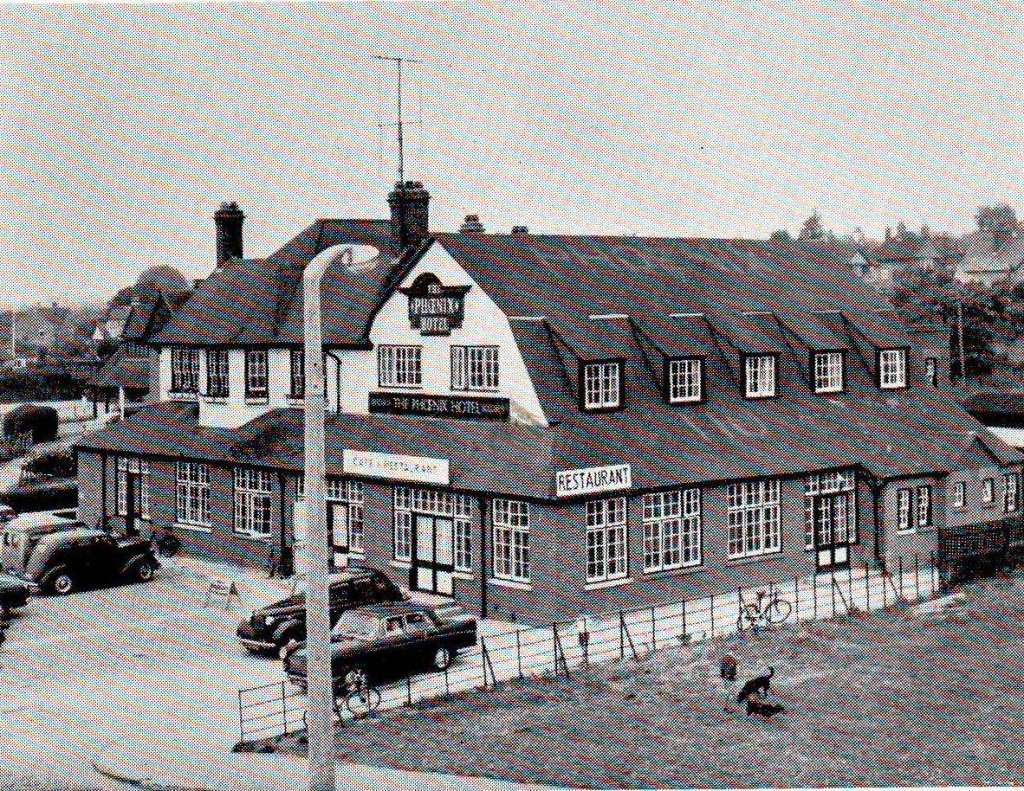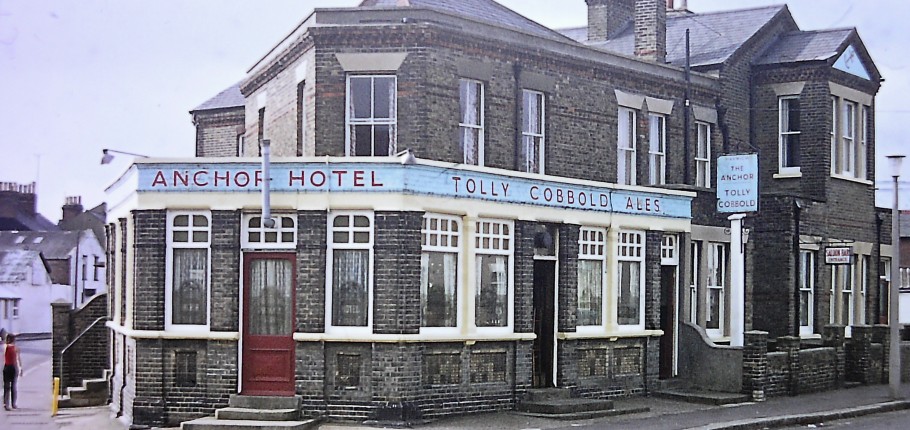
Public Houses and Hotels
Harwich is well known for its history, but there’s something else which the town is equally famous for, it’s Public Houses and Hotels.
With the presence of so many varied occupations and visitors to the town, it was understandable that the number of Public Houses grew.
In the olden days Harwich was a very famous and important sea-crossing and people would come here with a retinue of servants looking for a place to stay, nearly every public house or the house next door would have accommodation, In its heyday Harwich was an important port, dockyard and garrison town it was well supplied with Inns and Public Houses. Present in the town were Coastguards, the Royal Navy, Merchant Seamen, Fishermen, Army Regiments, as well as local folk. Who all wanted beer.
Many of the old pubs have disappeared and of those that remain most have been changed beyond recognition. As trade declined the old inns were knocked down or became private houses or shops.
It is a fascinating experience to wander round the narrow streets of Harwich, Slipping down narrow passages, glimpsing the sea, Dreaming of the ghosts and countless sailors ,famous and infamous who Have wandered along these ways, sailors of the mayflower ,sailors of Nelsons, fleet ,sailors of two world wars.
ALMA INN, 25 Kings Head Street
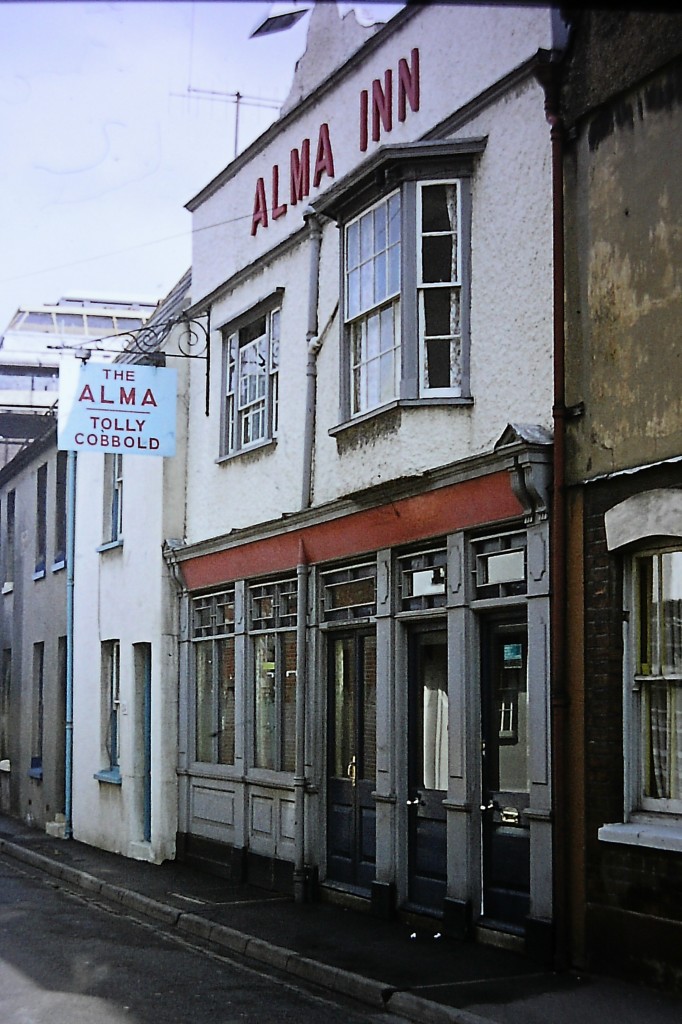
The Alma
The Alma Inn was once a merchant’s house owned by Captain Twitt, a relative of Thomas Twytt, a merchant brewer of Harwich in 1599. the Alma traded as a alehouse around 1871 as The Alma Dining Rooms and was opened by Charles Cullingham, a brewer of Ipswich. It then became a Tolly Cobbold house. Arthur chambers and his family came to Harwich due to the talk about the development of Bathside Bay, his father William Chambers took over the licence of the Alma in 1932, at that time nearly all of the publicans were pensioners, the family went onto be connected with the Alma up to 1987. It changed name to the Alma at the turn of the century after the closure of the Tolly Cobbold Brewery. The Alma was taken over by Pubmaster, who in turn were bought by Punch Taverns in 2004. How the Alma pub got its name is not known, an Alma is actually an Egyptian dancing girl, and there is no obvious link between the land of the pharaohs and King’s Head street pub. It is more likely to be named after the Battle of the Alma in the mid-19th century.
The Alma is still trading today. Photo by Dean Whattler.
ANCHOR HOTEL, Stour Road, Bathside
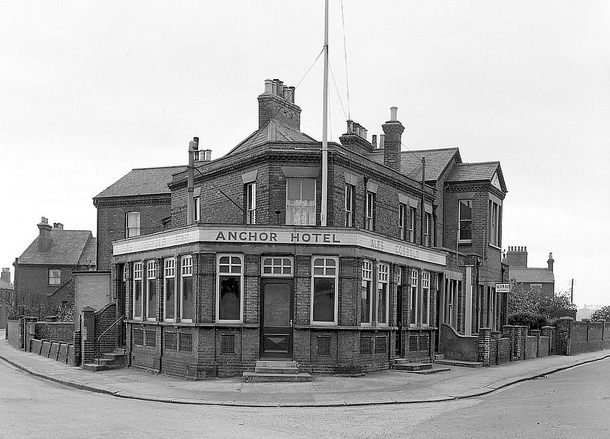
Anchor Hotel
The Anchor. an old Bathside pub built more than 130 years ago, was once the centre of the community. Trading in 1875. Tragedy struck at the pub in 1953, when a seven foot tidal surge from the Noth sea was whipped up by a gale force wind, sending an avalanche of water across the low-lying part of the town. Bathside was particularly badly hit, with water up to the rooftop of the Primary school. the Anchor’s landlord Pearl Lofts was one of the eight people in the town who lost their lives in the floods and drowned in the cellar.
The Hotel was used to hold many functions and was a popular venue for weddings. It closed in 2004 and has since been demolished.
ANGEL, Harwich Quay
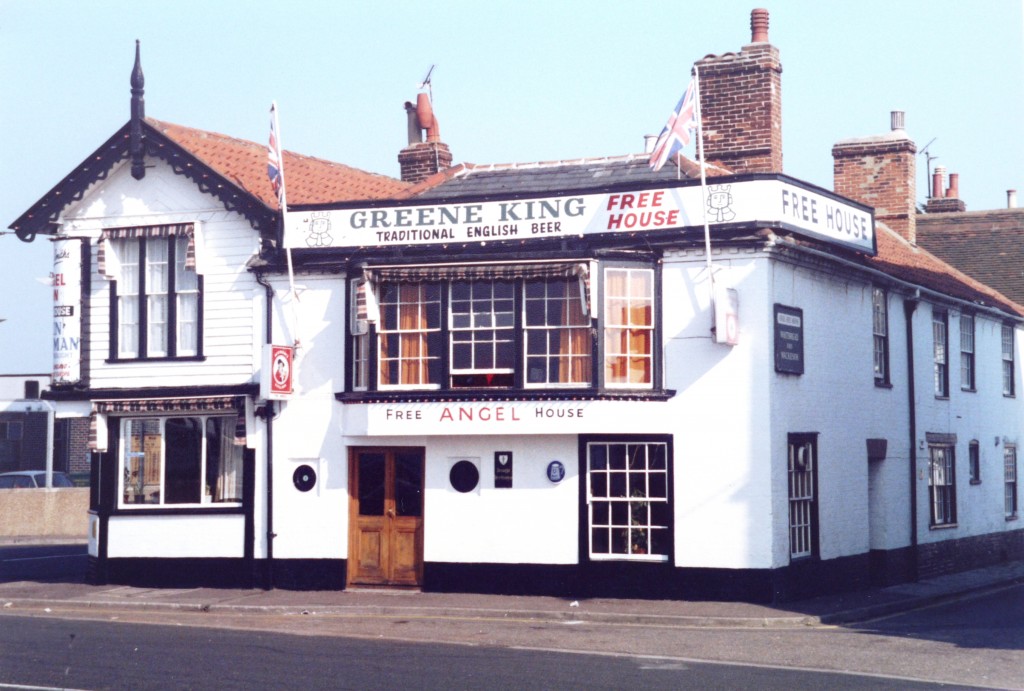
The Angel
The building we see today was built in 1824 and was owned by the Corporation and leased to Thomas Cobbold for £10 per annum. Thomas was the son of John Cobbold who ran the family’s brewery operation at Ipswich whilst Thomas owned and ran the Harwich concern with a brewery on the Quay and 20 inns and public houses, including the Angel which was next door to the brewery on the Quay. The new pub probably stands close to the site of the old pub.
The name Angel, some say, suggests it too may once have been the haunt for prostitutes. built in 1824 the Angel was owned by the corporation and leased to Cobbold. this Quayside pub was a popular meeting place for Naval officers from the reserve fleet moored in the river as well as those from Hms Ganges. The pub had a children’s room in the back part of the pub, where families could leave their children whilst enjoying a drink. the building was sold to the Milton group in 1999 and restored As an annexe to the Pier hotel.
Photo by Dean Whattler.
The BRITISH FLAG, 57a West Street
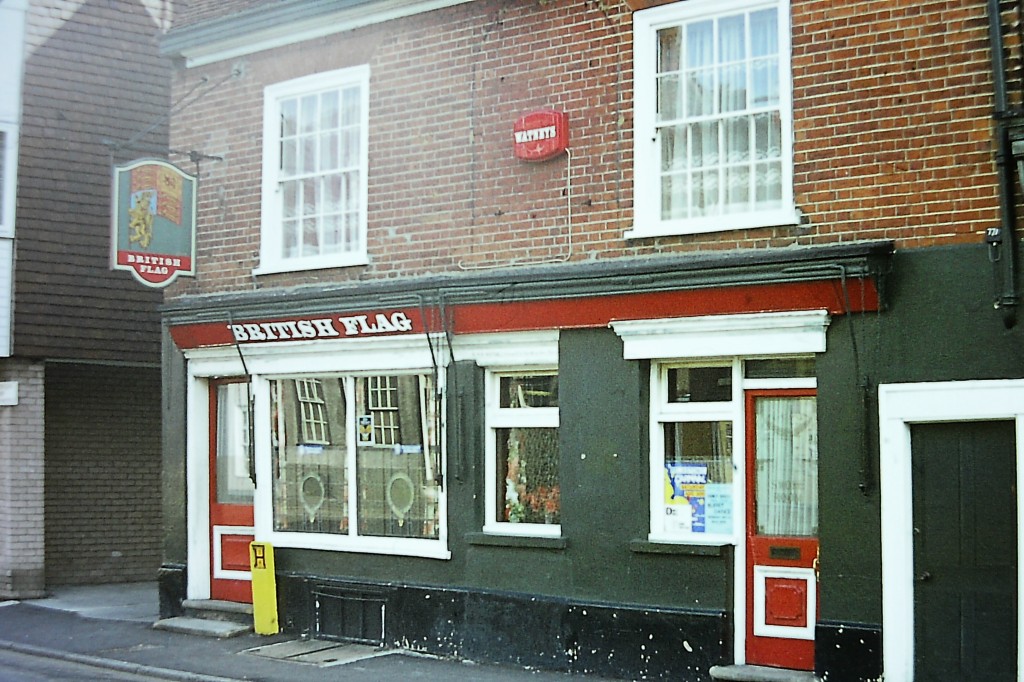
British Flag
From a Beer house in the 1870s, then managed by Fred Kettle for around 20 years, ‘The British Flag’ passed into the ownership of the family who were to occupy it for around 70 years when Mr and Mrs Stevens became licensee in 1911, The Building was altered in 1916, with further alterations During the tenancy of Mr and Mrs Tootell in 1932. In 1907 two labourers of ‘no fixed abode’ where charged with wilful damage to a plate glass window. The men had gone to the police station asking for a bed for the night.
When they were refused they said lock us up we have thrown a chisel though a window in Golden lion lane. When the police found the story to be true the men were apprehended. There sentence was fourteen days hard labour. landlady Lydia Whitnall recalled the Great Flood of 1953, When I went out and looked outside the water was rushing up just past the Packet Inn.
I went rushing in and told my husband, so we put our Wellies on and went down and got all the spirits out of the cellar, we got the spirits up and put them on the counter, and then I phoned Mr Flood who lived opposite the Norfolk Dining Rooms, by the time we got the Spirits up we were wading in it. we then had to sit upstairs until the water receded at about 5am. There was mud everywhere…empty barrels floating in the cellar, but people expected us to keep going. As it transpired the Flag was the first to re-open and I can remember the very friendly Atmosphere within the town at the time.
The Pub is still trading today. Photo by Dean Whattler.
COACH & HORSES, 2 Church Street
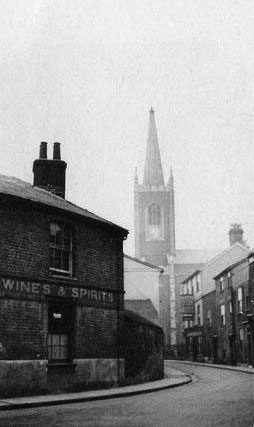
Coach & Horses
The Coach and Horses, Hanover Square, (later known as the Bull) with stables behind. The 19th century Post Office mail coaches started from here. It was reported in May 1889 that the body of Mrs Goodwin, wife of Mr Goodwin landlord of the Coach & Horses, was found ashore on Stone Point. A bunch of keys with her initials on putting identification beyond all doubt, money and a gold watch reported to be on her person were not found. Landlord David Miller’s motto was. “Value for Money” Civility, and a warm welcome to service (Navy and Army) and ex-Service Men. Teas Provided at a few Minutes’ Notice. Splendidly Furnished Smoke Room, suitable for Concerts, etc.
The pub Closed 1936, and was once a showroom for Harwich Radio and Cycle Supplies, today it forms part of a private residence.
DUKE OF EDINBURGH, 65 West Street

Duke of Edinburgh
Anthony Cox leased the pub, originally known as the Harwich Arms, to Thomas Cobbold in 1824, later taken over by the Colchester Brewing Company. By then the name had changed to King William the fourth around 1870 and then to the Duke of Edinburgh in 1892. The papers reported in 1876 that a bull being driven to the railway trucks with other animals strayed from the path laid out for him by the drovers and scampered up West Street, the bull without ado, bet0ok himself straightaway in through the front door of the then King William the Fourth, until even his tail was lost from view. The uninitiated were soon acquainted with the facts by a crowd of on lookers in the street.
The drovers and a crow ensured the bull retraced his steps until he reached the cattle pens. The pub later became a free house and changed its name to the Billy which closed in 2010. The building was listed Grade II by English Heritage in 1972.
“Why the Billy” even the licensee or the Brewers are unable to solve, apparently the name goes back as far as anyone can remember and the only suggestion as to why the name the Billy is when the pub was first named after the then Duke of Edinburgh “William”.
When it closed in 2010 the pub had previously been called the Harwich Arms, William the Fourth and the Duke of Edinburgh.
DUKE OF NORFOLK, 13 Kings Quay Street
Originally the site of the 18th century ‘Kings Arms’ which was well known for its dancing bears in 1753. It later became the ‘Privateer’ about 1762 until being rebuilt. The Duke of Norfolk was considered of some historical importance, Parts of the interior were said to be Tudor origin, and it was believed that the Pub was a remnant of a larger manorial palace associated with the De brotherston household. it closed as a pub on December 15th 1915. during the 1920s/30s it was used as a fried fish shop. Around 1928/1929 a Proposal was put forward to restore the property to its former Tudor glory. However this was eventually considered too expensive and the plan was abandoned. In 1930 the building was stripped of its antique features for Private sale. The building was demolished in 1947 after the council purchased the site for re-development.
DUKE OF WELLINGTON, 18 Kings Quay Street
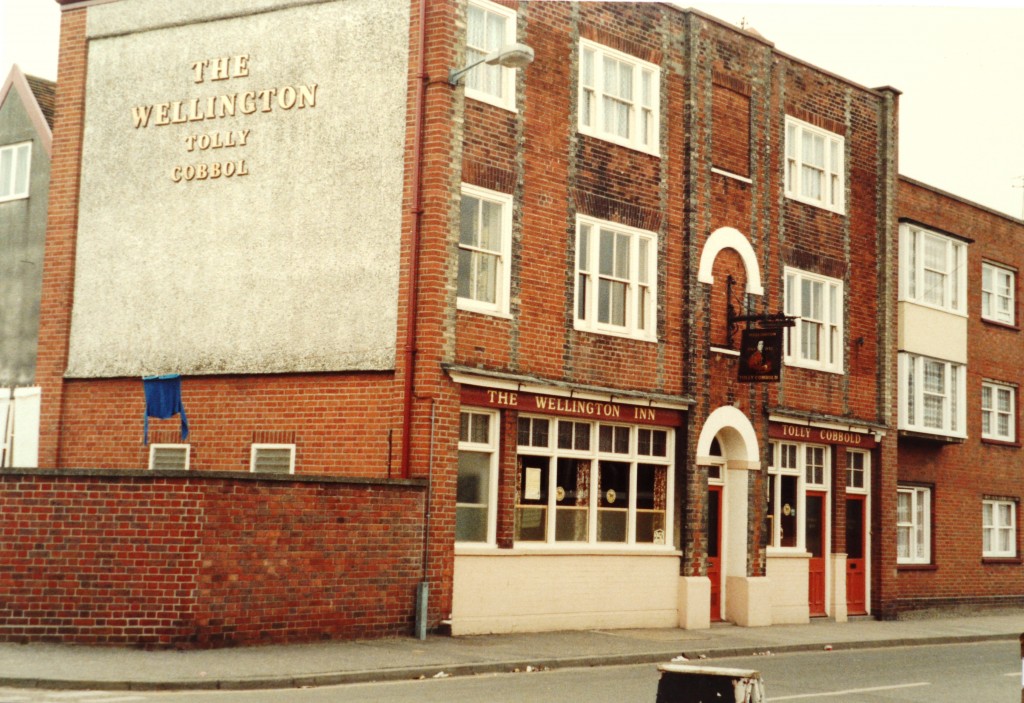
Duke of Wellington
Trading since 1845 when it was a former Tolly Cobbold pub. The building is built in red Flemish-bond brickwork, the front has a plain parapet and an off-centre column of the facade projects slightly to house the old main doorway and bricked-up first storey window recess, both with painted semicircular arches on impost blocks. In 1897 plans were submitted to alter the premises,one room was to become a music hall and permission was granted under the Amended Public Health Act,which gave power to any publican to use his premises as a music hall.
Messrs Craske & Sons offered the fully licenced pub and other freehold properties, for sale at the Three Cups Hotel. There was a good attendance of people from the town and surrounding areas. The Wellington was let to Mr J.D.Cobbold in 1907 for £ 125 a year, and occupied by Stanley Greenwood.
The “Welly” closed in 1999 and is now residential properties.
For Sale.
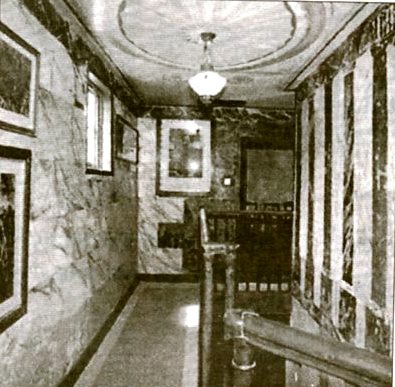
Duke of Wellington
In 2003 The former Wellington Inn was on the market for £375,000, The Grade II listed building which was mainly Georgian includes, a ballroom, cellar and eight bedrooms. The main reception room, which used to be the bar area, measures 21ft 4ins x 21ft 5ins with a recess period-style stove and fireplace. The second reception room was a former ballroom with dimension of 30ft 2ins x 29ft 6ins with a fireplace, tiled flooring, recessed brick built fireplace, four deep glazed sinks, range of wall shelving and steps leading to wooden floors. There was also a shower with marble floor and walls and lights which shine through slabs of translucent marble.
The first bedroom is 20ft x 13dt 6t ins and includes a Georgian fireplace and wooden flooring.
There is also a backhouse which features two more reception rooms, a kitchen, bathroom, two bedrooms and 25ft 11ins x 13ft 10ins cellar.
Outside there is a courtyard-style garden which gives access to a further cellar area.
DUKES HEAD, 22 Church Street
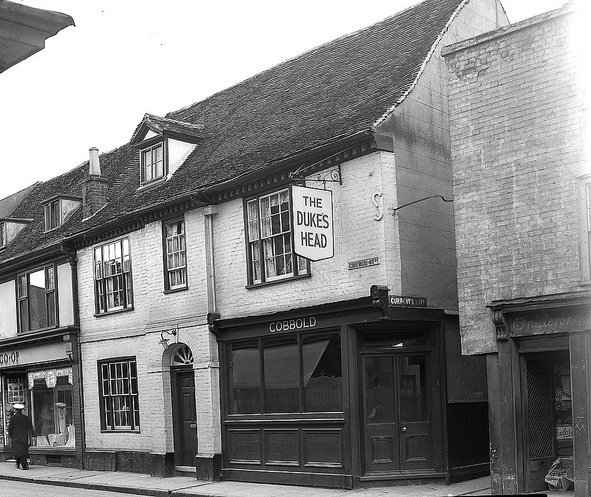
Dukes Head
On the corner of Currants Lane stood the Duke’s Head known as a dwelling in 1632. Moving back in time to 1746 it is easy to see why Thomas Cobbold set up where he did. He had been plagued by the troublesome water supply at Harwich for some time and although moving up-river disconnected him from some of his customers he could obtain good water and malt in Ipswich and use the Harwich operation as a staging post. In fact it is quite possible that the Cobbolds started off in Ipswich malting barley and decided to take over the Harwich Brewery. The pub Closed on the 6th June 1971. and is now a private house.
Last Orders.
Sunday night was a time for present giving, mixed with songs, merriment and memories at the Duke’s Head. The pub, which has been run by licensee Mrs Kitty Ingram for the past 18 years, closed its doors for the last time.
The march of time brought with it the need for improvement. It wasn’t economic to spend so much money on the old building, which dates back to 1500.
To Mrs Ingram, her husband, and the Duke’s Head “regulars” it was a sad occasion, Yet they put a bold face on it and held a week of farewell parties, culminating in the big close down on Sunday night to the strains of “Auld Lang Syne”.
She added: “This was the very last busiest pub in the district for miles. The brewery asked us if we were giving the beer away, we sold so much.”
Sitting in the deserted bar Kit reflected: “ I will be very sad at leaving Harwich. I love Harwich and its friendly people. I shall be so bored being a housewife. I will miss all the company. ”
ELEPHANT & CASTLE, 11 West Street

Elephant & Castle
This pub was purpose built by Tollemache & Company around 1905, and replaced the original building which traded as a pub and alehouse in the mid-nineteenth century. Previously in the 18th century trading as the Golden Lion, 19th century the Welcome Sailor, Re-built by Edward Saunders in 1896 and Renamed Elephant & Castle until its closure in 1979. Re-furbished and reopened in 1985 as The Haywain, and renamed Mariners in 2002.
Since then it has been renamed Shakers Bar. a popular attraction was the aviary where an assortment of birds were housed in the rear yard. It retains its original external appearance.
Photo by Dean Whattler.
FLEUR de LYS, 2 Market Street
The Fleur de Lys, which has a Elizabethan courtyard and is now known as Cobbolds Court, was once Cobbolds Yard and sold in 1911 for the purpose of erecting a well-equiped Naval sailors home. Formerly known as the Tabbard between 1658-1746 Later becoming the Dolphin. It was sold in 1742 by Abraham Groom to Thomas Cobbold who later sold it on to the Rolfe brewing family. The site now is occupied by the Mayflower House.
FORESTERS ARMS, 5 Church Street
The Foresters Arms was an ale house from 1800 to 1941 opened in April 1876 by Daniel Barwood, and Closed on the 28th July 1942. Restored by present owners who moved in in 1953. The plaque on the side of the building reads ‘Said to be the oldest house in Harwich (c.1450). The old inn was never referred to as Foresters Arms but always as the old Drum and Monkey. A hook in the central beam of what is now the sitting room from which had hung a drum. It seemed that a monkey would bang the drum to warn the licensee that he had a customer waiting, another person claims that “old Lady Barwood” would send the monkey round for a penny on the drum when bad language was used.
Three generations of Barwoods kept the pub before serious damaged by incendiaries forced them out in World War II. Foresters was restored in 1953 by Winifred Cooper, MBE, President of The Harwich Society, it remained her home for nearly 50 years.
The building is estimated to have been built in the 15th century, but Mrs W. Copper thinks the oldest part probably dates from the early 16th century. Unfortunately. The old deeds which went back to the time the inn was erected, were destroyed during the war when they were housed in the Chancery-lane safe deposit, which was bombed in 1941.
Mrs. Cooper first became interested in the building in 1946, but discovered that it was still licenced, and decided it was of no use to her. Every time she went to Harwich she looked at the inn, and became more and more intrigued with the idea of living there. It was not until July, 1951, that she finally became the owner.
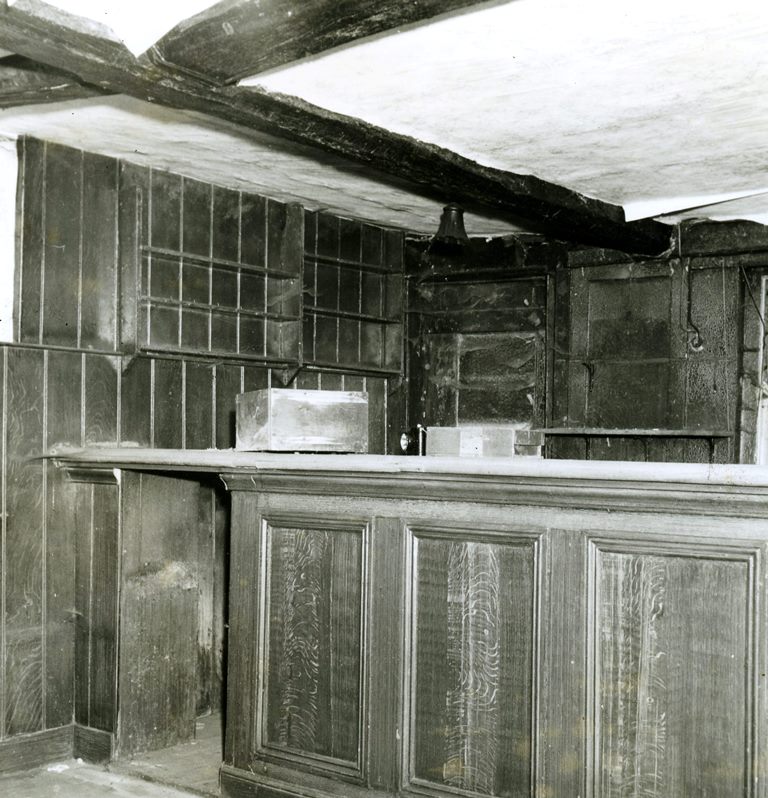
Foresters Arms
The two rooms facing on to Church-street were both bar rooms, one the public bar, and the other known as the snuggery.
These were the only two ground floor rooms in the original dwelling house, and the dining rooms and kitchen lying behind the snuggery appear to have been added at a later date. The dining-room which was used as a bar parlour before the inn was closed, has a very low ceiling.
The snuggery is to become the hall, and this will necessitate moving doors and sealing up door ways.
Upstairs there are two low ceilinged attic rooms, a large and small bedroom. No major alterations are required there, but the part of the upper floor overhanging the street will have to be rectified.
It is now the headquarters of The Harwich Society.
GLOBE, 5 Kings Quay Street
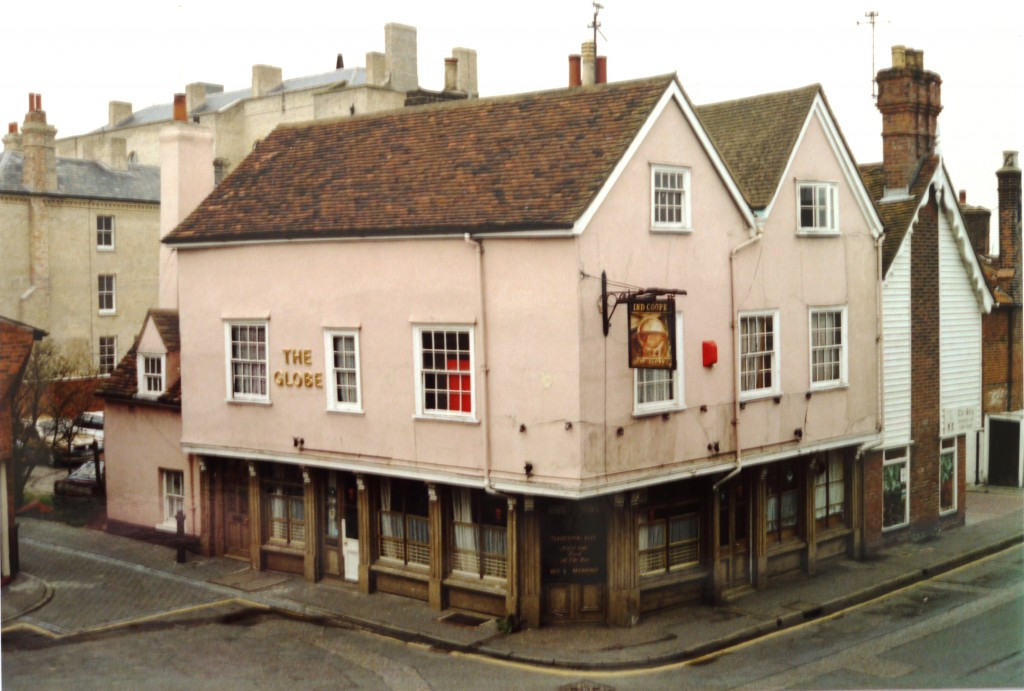
The Globe
A Picturesque inn with its gables and its Treasure Island atmosphere. Inside are old beams, and upstairs the ceilings where once decorated with plaster motifs of Fleur-de-lys, Tudor roses and unusual carbuncle shapes. the pub contained a Wash-house, Pantry, Tap Room, Parlour, Cellars, Bed Rooms,two Attics and Yard. The Globe was the town’s oldest surviving pub. It began trading in 1753 when it was owned by Cobbold,who sold it at auction in 1837.
After a short period of closure,it is trading as a popular pub again .
GOLDEN LION, 17-18 George Street
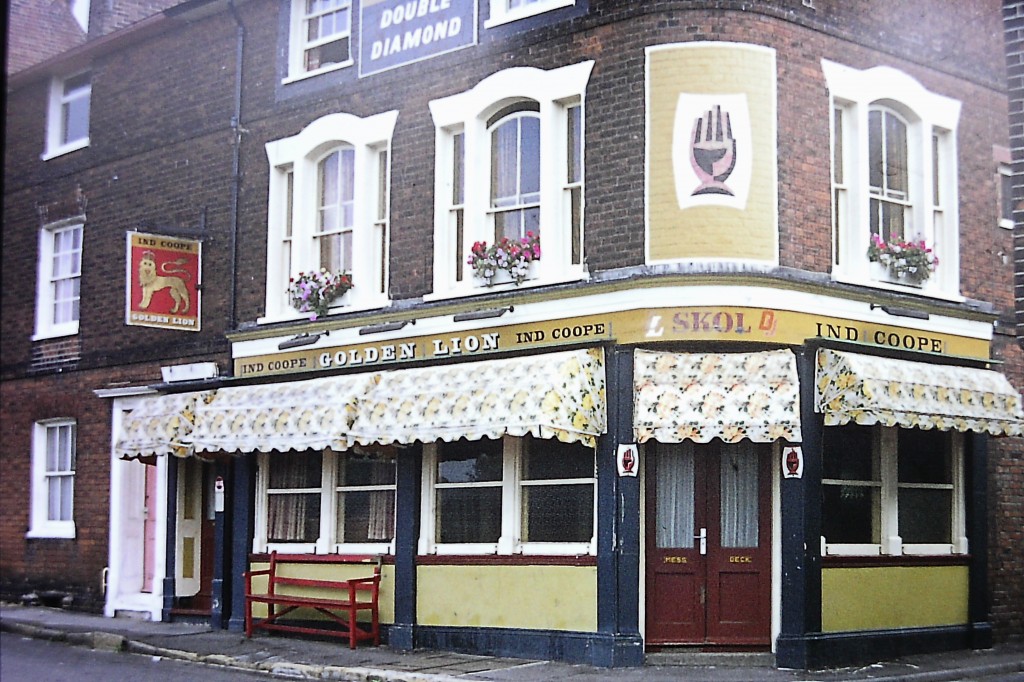
Golden Lion
Cutting through Golden Lion Lane brings you to the Golden Lion, In 1873 it was a beer-house owned by J.F.P and A.T. Osborne and was taken over in 1910 by the Colchester Brewing Company,then post in 1925, by Ind Coope. It was granted a full licence in 1952. The pub later became Blazers in the early 80’s when all the photographs and mementoes on the walls were destroyed. In 1942 Mr and Mrs Dean managed the pub and were paid £2 10s per week with a 2s 6d drink allowance, when the Foresters Arms closed Mrs Dean who was the daughter of Frederick Barwood declined the offer to run the pub. Trading today as Treo Bar & café. Photo by Dean Whattler.
HALF MOON, 15 St Austins Lane
The Attractive Grade II listed building was previously the Half Moon pub, which is known to have been trading in 1753 sold by auction in 1837 by Thomas Cobbold and taken up by Nathanial Cobbold, who sold it on to the Colchester Brewing Company. In 1909 the body of landlord Benjamin Colthorpe was found in the dykes near the Old Smack, he had financial problems. The inquest verdict was suicide while suffering temporary insanity.The Half Moon closed its doors in the 1960s before becoming Half Moon Antiques for some thirty years. Today it trades as the Thai Up The Quay Restaurant.
HANOVER INN, 65 Church Street
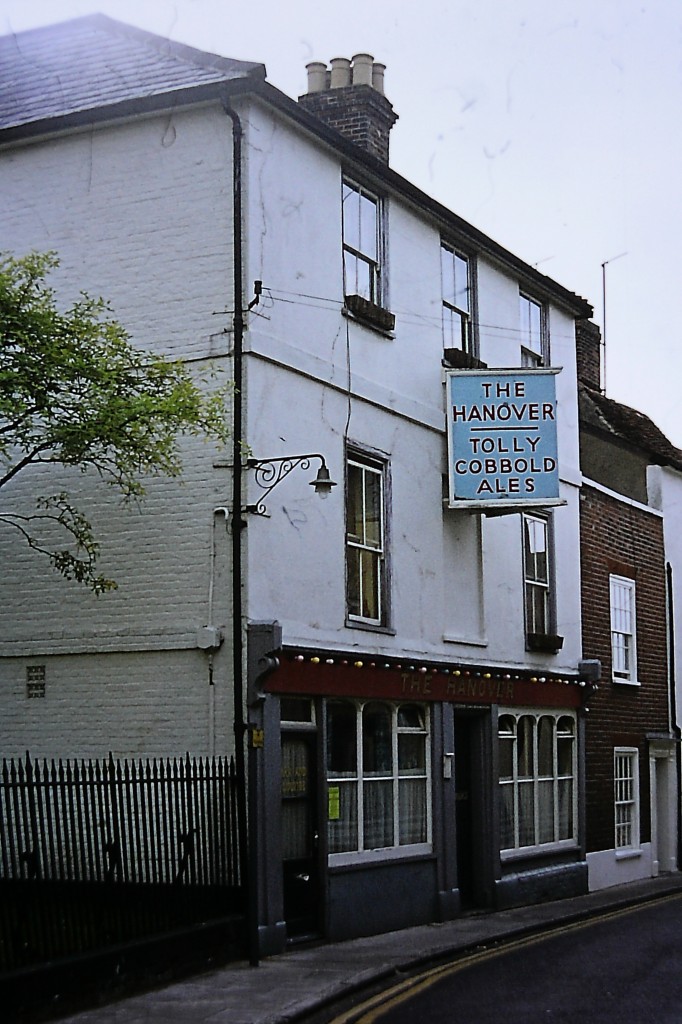
The Hanover
Originally 16th and 17th century houses with the front rebuilt in the early 19th century. In Victorian times it became a Dairy and Dining Room. The Dining Rooms were converted to a public house in the 20th century. In 1872 the pub was licenced as a beer-house and became known as an inn. Many visitors to Harwich make for the Hanover Square Dining Rooms, which were once under the proprietorship of Mr Lawrence for some forty years. the premises are excellently adapted for business. well situated close to the church and the esplanade, there is a magnificent dining-room on the ground floor, and also one upstairs. It only remains to state that the charges throughout are on a remarkably moderate scale. It is a pleasure to make mention in this review of a house which stands so well in the estimation of its patrons as that so ably presided over by Mr William Lawrence.
KINGS HEAD, 8 Market Street
The King’s Head was known as the house of the dancing bears – Seamen bringing bears ashore to dance in the pub. It was owned by Thomas Cobbold form 1753, who sold it at auction in 1837. The pub suffered a fire in the same year, landlord Mr Last being woken by a strong smell, Mr Last extinguished the fire which had been started by a mat in from of the fire and was compensated for the damage by his insurance company, like many pubs suffering loss of trade due to the departure of the Army and Navy the pub fell into disuse. The last landlord was Mr Lodge, who sold it to Mr Leonard Rose in the 1930’s after which it was converted to the Labour Exchange and later Bill Howlett’s General Store. Today it is a Private residence.
LIFEBOAT INN, 34 Kings Head Street

Lifeboat Inn
On the corner of King’s Head street known by locals as Dirty Street, stood the Lifeboat Inn, known prior to 1877 as the Red, White and Blue. it was owned by Cobbolds until 1869 when it was sold by auction to Charrington Nicoll for £640. In 1878 the Red, White and Blue was cautioned for failing to keep good order. The name of the pub was to change to the Lifeboat. At the renewal of licence in 1880, the turnover was 156 barrels per year. The class of people using the public house comprised of Pedlars, tramps, rag and bone dealers, organ grinders etc. The pub was demolished during the 1950’s as part of the redevelopment scheme. one customer recalls, The lifeboat was very small. 2 tiny bars, if you got 4 people in it, it was crowded.
LITTLE EASTERN, 11 George Street
The little eastern had undertaken some improvements in the 1914-18 war period, but looked well beyond the stage of improvements and finally closed in the 1950s. The licence was surrendered on the 6th March 1952 and put up for sale. For Sale: 17 September 1952.On the Ground Floor: Entrance Passage. Public Bar 17ft.10 by 12ft 7 with brick fireplace Bar Parlour 13ft 11 by 9ft 1 with barless grate and tiled surround, cupboard in recess. Large Cellar beneath the bars. On the First Floor: Landing, Kitchen 17ft 9 by 12ft 3 with sink and range. Living Room 16ft 3 by 12ft 4 with barless grate and glazed cupboard. On the Second Floor: Landing with cupboard Front Bedroom 15ft 10 by 12ft 3 with fireplace, cupboard and shelves in recess. Back Bedroom: 17ft. 9 by 12ft 3 with fireplace and cupboard.Box Room. Outside: Concreted Yard, Urinal, Two W.C.’s.
This picture shows Lilly Thorn, wife of landlord Bertram Keeling, who was the last landlord.
The pub closed in 1952 and was later demolished.
LONDON TAVERN, 21 Church Street
It was owned from 1870 until 1878 by the trustees of John Pattrick and traded as an ale-house. It was purchased by the Co-operative Society, who ran it as a pub and drapery store. After a fire in 1911 in the drapery department upstairs caused by a large wooden beam becoming overheated and igniting. The fire was extinguished and a considerable amount of damage was caused. It was fortunate that the fire was discovered prior to closing time, otherwise an outbreak of far greater proportions would have occurred. In 1919 the old Church Street pub was closed and the Co-operative society decided to build a new one opposite, The new public house included a tea and reading room as well as full tavern facilities. It was built in a mock-tudor style at a cost of £3583.12s 6d.
It became one of only two co-op pubs giving a ‘divi’ to its members. The building is now a private residence.
NEW BELL INN, Market Place
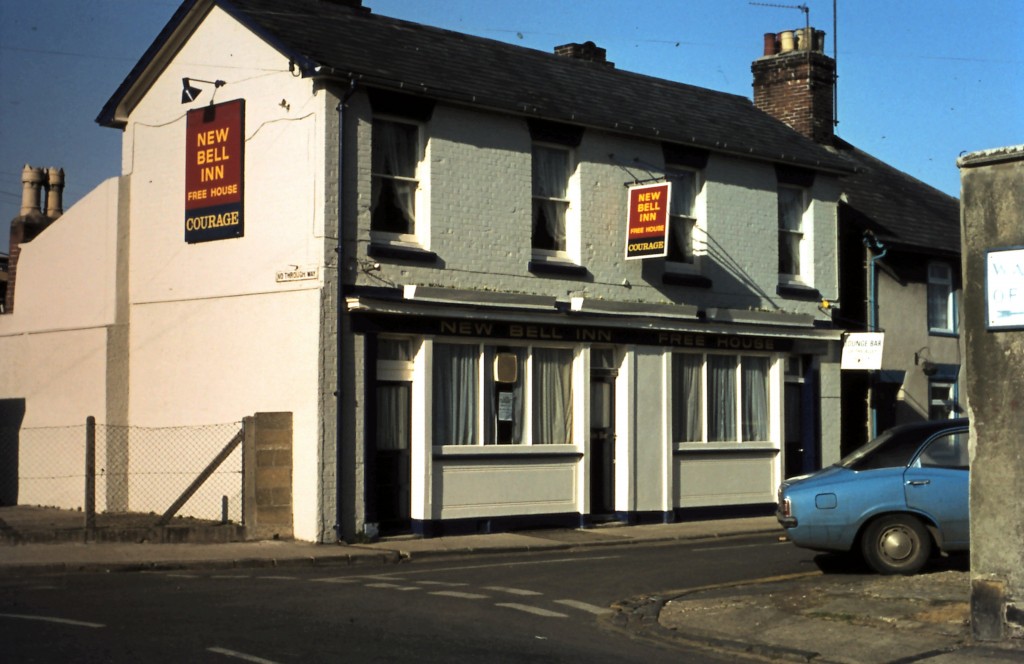
New Bell
That snug little quayside inn has been a hospitality since the early eighteenth century, originally a blacksmith’s from 1620 through to 1743 when the building had a change of use and was converted to a pub known as the Bell. The Royal Harwich Yacht Club also used the building as their club house. After they moved out, part of the building became a pub named the ‘Blue Bell’. The buildings on the site were destroyed by fire in around 1910 and the land became known as ‘Bell Yard’.
In order to avoid confusion with the Blue Bell further down the same road. The name was officially changed to the New Bell in 1908, and is still open today.
Photo. Dean Whattler
NEW SWAN, 14 Kings Head Street
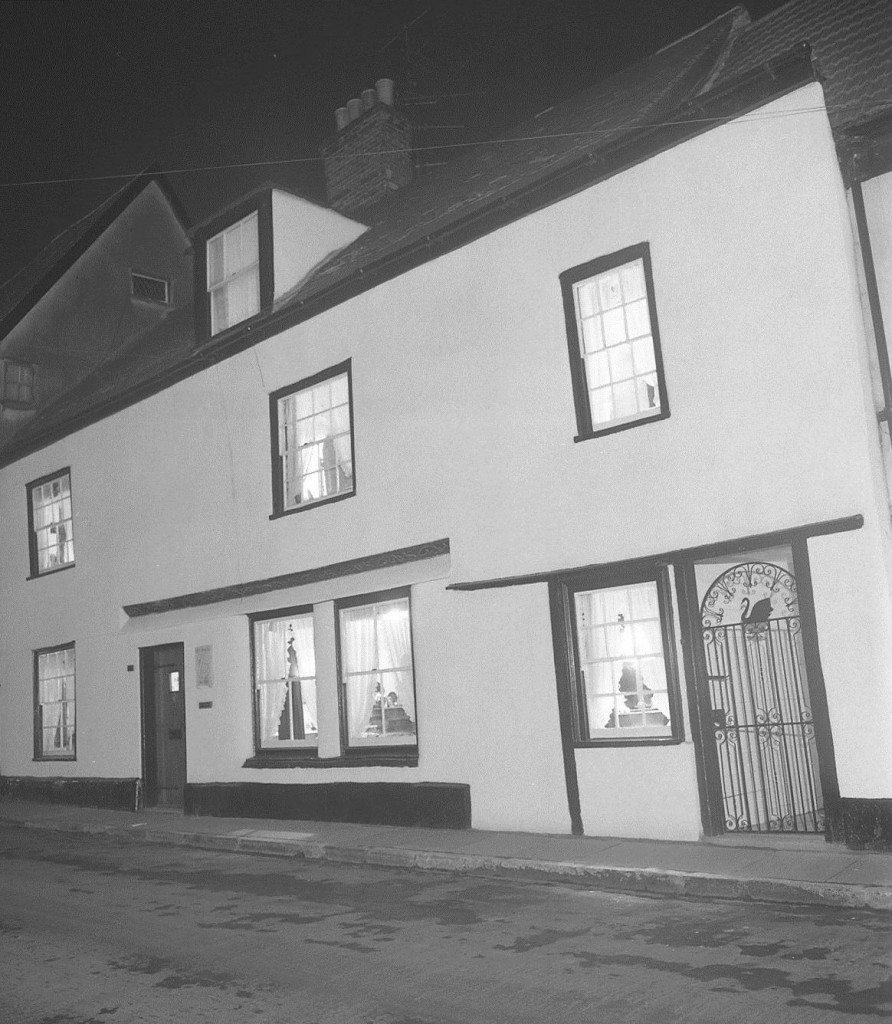
New Swan
At No 14 Kings Head Street stood the Swan inn, a rich merchant’s house – the original overhanging upper storey has been filled in to steal part of the pavement. There is a carved beam over the door. The pub Closed on the 8th March 1910. and is now a Private Residence. the interior contains further carved beams, a fine pargetted ceiling in six panels, and a medieval wall painting. the end gate and window is infilling of a previous entrance to the stables. after the First world war the last landlord, George Cooper, converted the right hand side of the pub into a general stores named Swan Stores. the building fell into decline in the 60,s and was later Purchased,restored and converted into private accommodation. previous names .The Ship, The Crown, The Bell and Dragon and finally The Swan.
In 1891 George Imray a seaman aboard HMS Eagle that was lying in the harbour, was convicted of stealing four forks and a knife valued at 2s 6d, belonging to the landlord Edward Long. Imray was fined 5s and costs of 11s. The Swan reverted to a private house and Art Gallery and in September 2017, for the first time in 100 years it will officially be serving alcohol again with a new bar built from scrap wood.
The Swan also has a four room bed and breakfast run by Sharon Shaw, with hopes of a new cafe at a later date. ”The Grade II* listed building was open for the bank holiday in September 2017, with a temporary events licence. It is hoped the bar will be open in the next few weeks.
PACKETT INN, 42 West Street
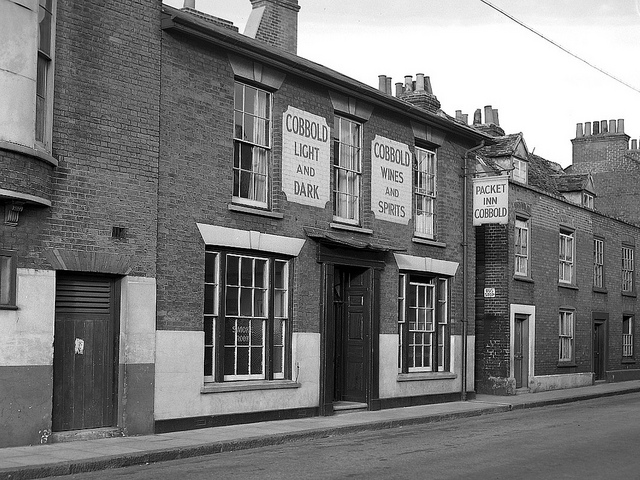
Packett Inn
The Packet appears to be a Georgian house built that way rather than being a frontage on an earlier structure. The Packett Inn, was converted from a house and in 1836 the address was shown as Custom House Lane. It was Previously known as the Smack 1782 and the Eagle Pacquet Boat. Inside the pub was a Bar, Tap room, Store Room, 2 Parlours, and five Bed Rooms. In 1919 the landlord Mr Gloster, and Emily Sealey employed a cleaner, Hilda Cooper, who was reputed to have the cleanest scrubbed tables of any pub in Harwich.
Allen & Betty Turner returned to Harwich to take over the Packett Bar in West Street, It continued as an Inn until the 1950s when it was delicenced and became a café. It was later changed to the Harbour café run by peter and June Marshall. in 2004 the pub reverted to being a house.
PIER HOTEL, The Quay
37 year old ex Londoner and businessman John Brice saw commercial possibilities; in 1850 he became a publican and purchased the old brewery site. Brice’s plan was to open a Hotel near the quay within close proximity of the Railway lines and accessible for travellers arriving and departing from the pier, Building work began in 1860 despite objections from other publicans he was granted a liquor licence and on the 4th September 1860 the Pier was open for business. The Pier made history in 1902 when it’s lease was taken over by Mrs Jane Dale who became the first female licensee after police objections.
The police objected to the transfer of the licence, mainly because the property was owned by a woman, but also on Account of the type of clientele it attracted, Nonetheless the magistrates approved mrs.Dale’s Application and the Hotel was subsequently re-decorated, re-furbished and open for business in October 1902.
The Pier hotel was taken over in December 1958 by the Charles Vernon Smith Group, It was developed by Mr and Mrs Smith into a first class hotel restaurant and in the 1960s it offered all modern facilities including a new harbour view.
Originally regarded as unnecessary and a failure, Harwich’s pier hotel was transformed into a building of international Repute and is now classified as; an eye catching building of merit’.. A significant local facility, Playing a crucial role in supporting local enterprise.
PRINCE OF WALES, 18 West Street
Trading from 1684 as a beer house, sold by Daniels Brewery in 1908 and converted in to a shop and later as council accommodation. Today its private dwellings.
RAILWAY TAVERN, 10 George Street
Trading from the late eighteenth century as a beer house and was finally demolished in 1976 to make way for flats. The pub was the scene of many gatherings; Fishermen would play quoits and have their half-pints of ale after a day on the water. Captain Precious, skipper of the Berlin would often stay at the Tavern when ashore in England. Sale Details. 17 September 1952. On the Ground Floor: Entrance Passage.Public Bar 23ft.10 by 15ft 6 with Tortoise stove. Bar Parlour 15ft. by 7ft 11 with barless grate. Back Lobby. Private Bar 11ft by 8ft 10 with barless grate. Living Room 16ft by 13ft 2 with barless grate. Kitchen 19ft 6 by 18 ft with range, sunk, fitted cupboards and shelves. Larder 9ft 2 by 8ft 7 Coal Store. Large Cellar beneath the public bar. On the First Floor: Landing with cupboard and fireplace. Club Room 40ft 8 by 19ft with two fireplaces and two doors. Front Room 14ft. by 8ft 5in with fireplace, divided from Club Room by a screen. W.C. On the Second Floor: Landing with two cupboards. Front Bedroom No.1 (17ft. by 8ft 5in.) with fireplace. Front Bedroom No 2. (17ft. by 9ft.) Front Bedroom No 3. (17ft. by 9ft.0 with fireplace. “L” Shaped Bedroom No. 4 (9ft. by 8ft. 5in overall). Back Bedroom No.5 (15ft. by 11ft. 5in) with fireplace. Back Bedroom No.6 (13dt. By 11ft. 3 in) with fireplace. Outside:Brick and pantiled Washhouse and Store with brick copper and range, Concreted Yard. Urinal. W.C.
ROSE & CROWN, 31 Church Street
An eighteenth century front on an earlier timber-framed house. Number 31 was once called the Rose and Crown, at the back of the Inn over the yard were salt-water baths for healing. It was said that Samuel Pepys came there and used them. There were also tunnels under the house that ran to the quay and to the Guildhall. Inside the house there were cellars and a large well in the yard. It later became a shop and fishmongers. The structure started life in the 16th Century as a timber-framed house but, today we see an 18th Century facade in red Flemish-bond brick, with a gabled roof with clay tiles, forming two storeys with attics. Today it has been restored and trades as the Samuel Pepys,better known by the locals as ‘Sam’s Wine Bar’.
ROYAL OAK, 22 Market Street
A three storey 17th century timber frame building which was not known for its hygiene in days of old. John Smith leased the pub to Thomas Cobbold on the 11 September 1757 for 5s, who in turn rented the property to occupant Mary Young, for one peppercorn rent. In 1888 landlord Mr William Hepper was charged with assaulting Charles Cavill of Harwich on the 30th May 1930, the magistrates dismissed the case, and ordered each party to pay his own costs. licensee Mr John Smith applied for renewal of the pubs licence in 1932 but was turned down on the grounds that the King’s Head and the Royal Oak were to closely situated and the licence was not renewed. the pub closed in March 1932 and is now a Private Residence.
ROYAL HOTEL, 43 Kings Quay Street
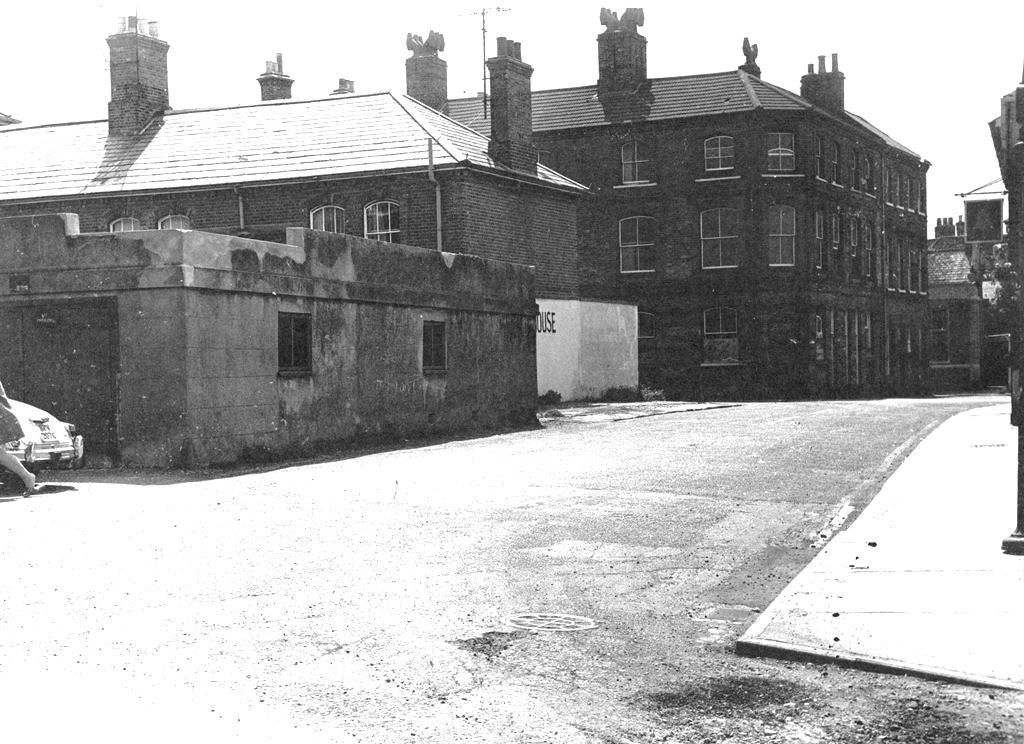
Royal Hotel
Built circa 1866 on the site of the former ‘Harwich Arms’. relinquished by Cobbold & co, the pub was sold in 1927 and became the Royal Flats. a new Royal was built in Dovercourt as a replacementBuilt circa 1866 and owned by Cobbold in 1921 the pub was modernised, with a modern rough cast Facade and a new roof. Like many other establishments trade declinded in the 1920’s and it finally closed it’s doors in 1930. The Royal was sold by Cobbold in 1927 and became the Royal Flats. In 1898 the Hotel was under the sole management of Mr and Mrs Bernard Asplen. A new Royal was built in Dovercourt as a replacement.
SHIP, 3 Kings Quay Street
A 19th century timber framed former pub which Harwich Council felt should be privately restored. restoration was completed by Tendring District Council at a cost of £25000, and the property then leased out as a shop and flat. The exterior was completely stripped and rebuilt using the original tiles. As with many other buildings this had a previous life in the seventeenth century as a Blacksmith’s then as a house and became a public house around 1743 known as the ‘The Bell’. The Ship, so it appears,was therefore not its original name. Charrington Nicoll leased it in 1910,but Cobbold took over the lease and finally closed it around 1927.
It was later used as a tearoom, bookshop, and a sweetshop. It was restored in the 1970s and became a gift shop and then a restaurtant as it remains today.
SIX BELLS, 14 West Street
Built approx 1800 it was later to become a bakery owned by Mr Carter baking bread for the Co-op . In 1923 the shop became a greengrocers, owned by Mr Andreotti. The property remained empty until Stan Humphries opened it up again as a bakery, The bakery in West Street had been in the Humphrey’s family for over 70 years. Frank Humphrey produced the mayor making spiced bun kitchels for more than 40 years. Stan and Ethel Humphrey took over the bakery when the Co-op sold it in 1936. Mr Humphrey’s son ran the shop with his wife Liz, before retiring in 2003.
SPREAD EAGLE, 74 West Street
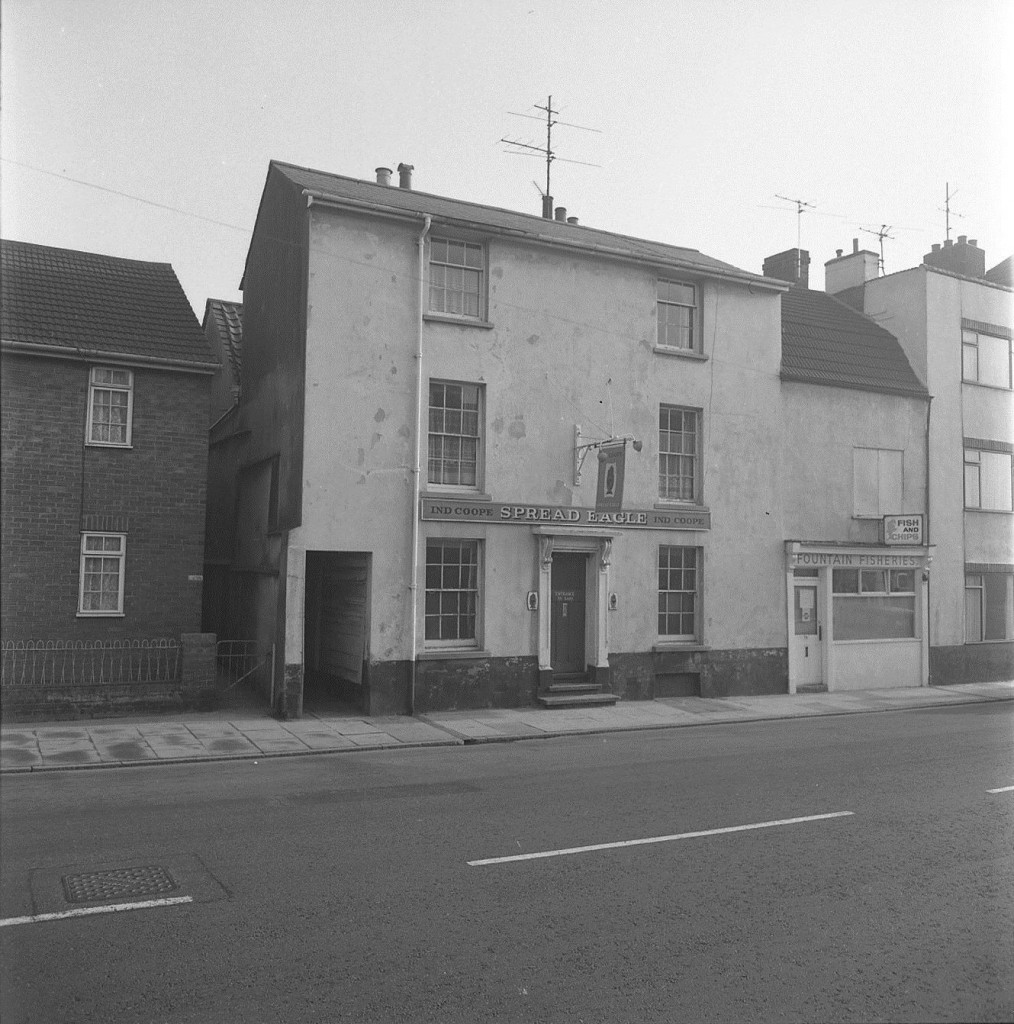
Spread Eagle
Eagle House. Formerly the Spread Eagle and Star.Early portion built in 1711 and new front added in 19th century.Between 1684 and 1860 it was known as the Star. The Spread Eagle was regarded as the town’s oldest pub.In 1914 its proprietor Mr Charles Hills applied for permission to re-build the premises as a modern ‘Mock Tudor’ establishment. The Council approved the plan but it was never carried out. In 1922 the Spread Eagle was the venue for a public meeting that resulted in the purchase of the Royal Oak ground on behalf of Harwich & Parkeston Football Club. The £500 required was collected in under ten minutes and it was proudly claimed that the borough was thus assured of a football venue for perpetuity. The Spread Eagle was regarded as the HQ of the football for many years afterwards.
In 1940 the Spread Eagle became owned by brewers Ind Coope and stayed in their ownership until it closed in 1954 and became a private residence called Eagle House.
STINGRAY, 56 Church Street
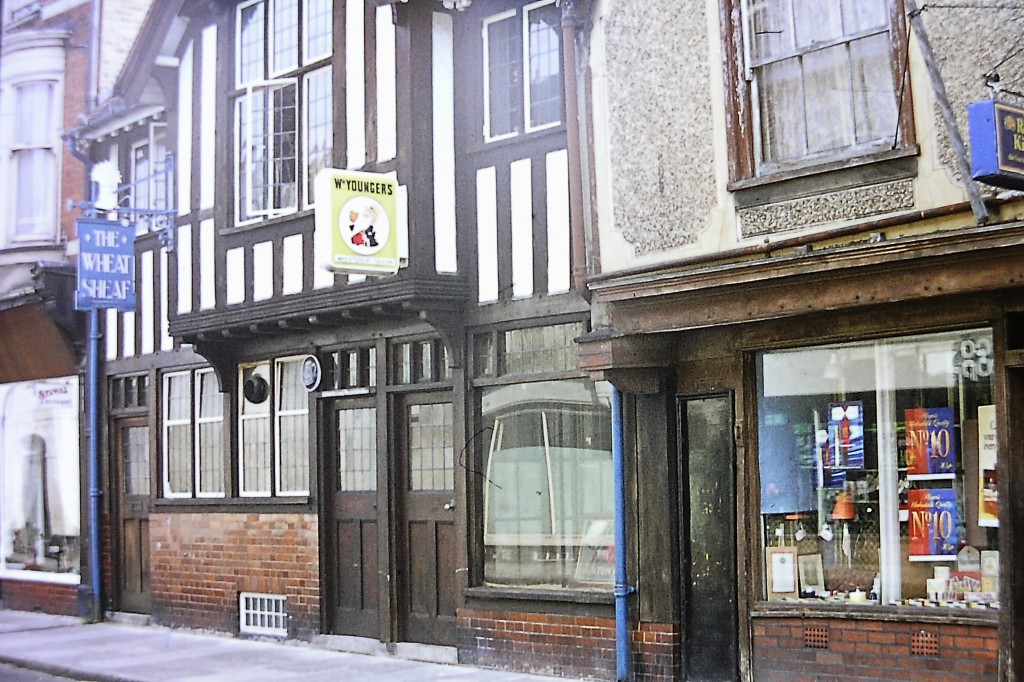
Wheatsheaf
The Wheatsheaf was opened by the then Harwich Co-Operative Society in 1920 an was the only license held by the society. it was ‘Divi with your beer’, the Co-op giving its members a dividend with their beer, many members keeping their ‘divi; until Christmas when they could buy bottles of beer for the festive period. Divi with drinks made a lot of difference to the people of Harwich in the days when wages were low. The pub changed its name in 1976 to the Stingray.
It was built on the site of two ancient houses no’s 55 & 56 Church Street, which were demolished to make way for the ‘new London Tavern’. The building was a combined pub, tea room and reading room and was one of only two Co-op pubs in the UK. Remembered as the pub which gave a ‘divi’ with a pint!. The building of the new Tavern- subsequently renamed ‘Wheatsheaf’ cost a total of £3583.12s.6d which was a large sum of money at that time. It trades today as the Stingray.
Photo by Dean Whattler.
THREE CUPS, 64 Church Street
The Three Cups Hotel was situated next door to the Parish Church of St. Nicholas in Church Street, People often asked “But why ` Three Cups`?, the Three Cups are said to have been the arms of the Cavendish family – one of whom, Sir Thomas Cavendish (1557-1592) was the terror of the Spaniards, and in his little ship, the “Desire” of Harwich, he made a successful voyage round the world-a superb feat of courage, skill, and endurance in those days. Naturally the town desired to honour such a worthy son.
Originally an L shaped early 16th century building with another wing added in the 17thcentury and later re-fronted. the building had many improvements including a Georgian Facade and an archway at the rear. On the first floor level there was a late Tudor plaster ceiling and a staircase with twisted Balusters of circa 1700. The structure was remodelled in 1949, when the top storey and archway at the rear was removed. Many famous people have enjoyed hospitality at this ancient establishment.
The Hotel was very spacious with its comfortably furnished lounge, a Dining Room, and Private Rooms for Teas, Reception, and other functions. There were a number of comfortable Bedrooms with gas-fires and modern fittings. Electric lighting was installed throughout. Nelson ? A carving of Lady Hamilton is a reminder that Lord Nelson was living in the Three Cups while the fleet was re-conditioning in the Harbour, but there no documents to prove that Queen Elizabeth I or Lord Nelson actually stayed here.
The Three Cups closed in 1995 and is now a private dwelling.
WHITE HART INN, 3 George Street
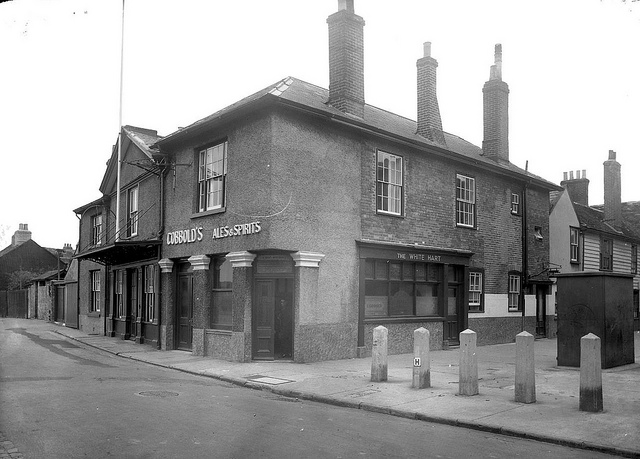
White Hart
The White Hart had connections with the coaching trade, it was 2 storeys high and had a frontage of 55 feet. There was a bar, sitting room, Commercial and coffee rooms, smoking and billiard rooms, In fact, the White Hart had Everything for commercial and residential requirements. A central quadrangle with a glass roof which had vines with bunches of luscious grapes trained around it in the summer. the secret of such fertility was the beer slops and barrel dregs. It is said that Doctor Crippen once stayed in a Room overlooking the well.
It was Trading from approx 1791. previously known as the Railway Hotel. with stables at the rear, it was used as a hospital during the Napoleonic war.
In the early 1890’s the front section was converted to the Norfolk Dining Rooms, when renovations were being carried out a white hart was discovered round the parapet. When the railway came to Harwich in 1854 and coaching became out of date the inn turned back to front and the courtyard was converted to attract passengers as they came off the train.
The White Hart was bought by the Labour Party in 1954 for a social club, The gallery was lightly boarded in, and the upper floor converted into flats, and the glass covered courtyard used for meetings and other social events. The White Hart was demolished in 1976.
WILD BOAR, 16 Kings Quay Street
Situated between the Duke of Norfolk and the Wellington Inn. It was trading in 1870 but is now demolished to make way for council flats. this picture from 1960 shows the demolished site where the Duke of Norfolk,Wild Boar and the Red Lion would have stood.The rear of the Wellington Inn can also be seen.
Other watering holes around Harwich which have long since been demolished included.
Almes Inn, Cock & Pye, Red Lion, Queens Head, Ship Tavern, The Bear/Kings Arms, The Blue bell, The Brewery Tap, The Gun/Bear, The Dolphin House, The Lion, The Rotterdam, Three Tuns, Three Crowns, Three Mariners, Griffin & Crown, Chequers, Carpenters Arms, Green Dragon,Two Brewers, Coopers Arms,White Horse (same site as New Bell).
Dovercourt, Parkeston & Tollgate
ALEXANDRA HOTEL, Kingsway, Dovercourt
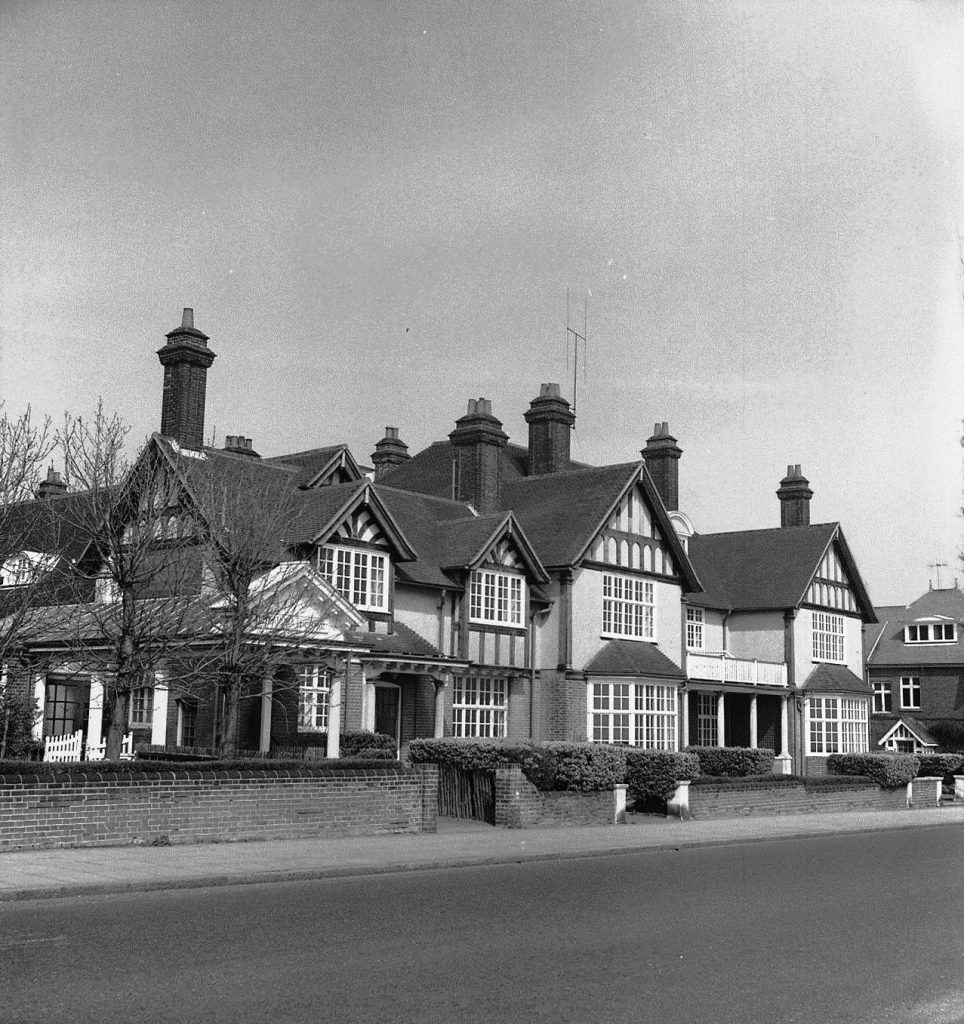
Alexandra Hotel
Officially opened on the 25th May 1903 with lunch for 120 guests entertained by a five piece Orchestra, the hotel was described as a ‘fine and handsome hotel’ and a ‘handsome and palatial building’. Designed in the Queen Anne style by Sherrin and situated in 3/4 acre of land overlooking the bay, the driving force behind the hotel was Thomas Moran. The opening luncheon for 120 guests was entertained by the five ladies of the Nell Gwynn orchestra. The entry for the guests is in Marine Parade, leading into the chief apartment on the ground floor, and out of which a handsome oak staircase gives access to 40 bedrooms and the suite of rooms above. In addition to the dining, drawing and billiards rooms on the ground floor, there was a restaurant which could be entered from within the hotel and from the street entrance.
The ‘Alex’ is now a Residential Home.
BIRD IN HAND, 567 Main Road, Dovercourt
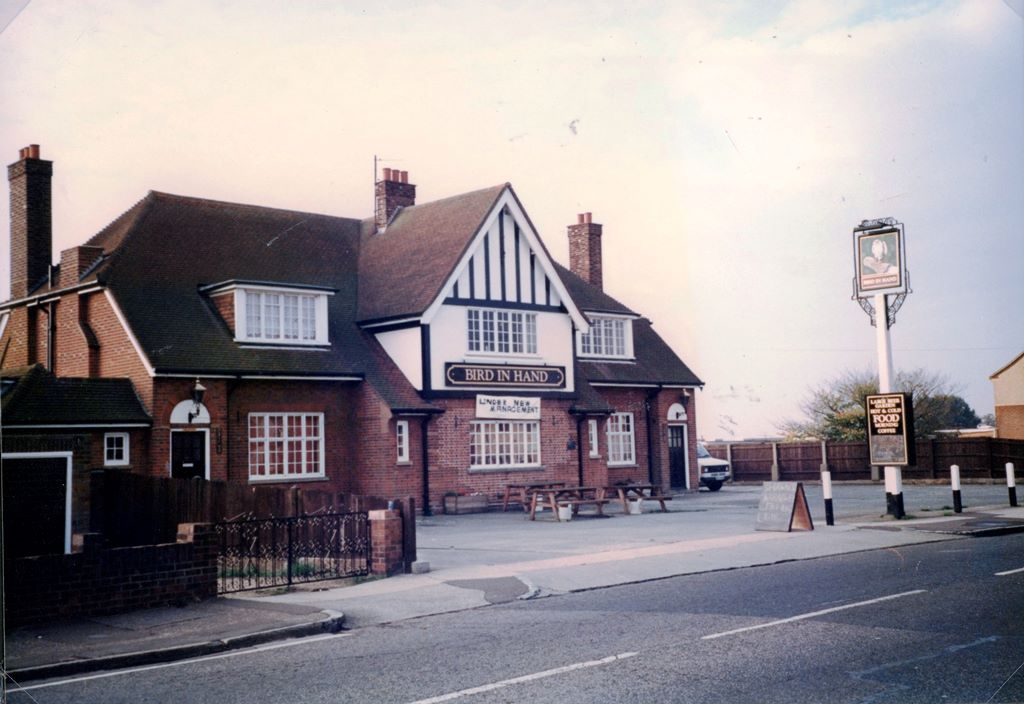
Bird in Hand
The original Public House was situated at the east end of Fitzgerald cottages on Dovercourt Green and in 1915 the building underwent major modernisation ,including the landlords living room into an additional bar and the requirement of moving the staircase to the rear of the property. The public house closed on the 8th March 1938 when the licence was transferred to a new building opposite. The New Bird In Hand was built around 1936 and remained open until 1998 when it was demolished for housing.
CLIFF HOTEL, 22 Marine Parade, Dovercourt

Cliff Hotel
In the 1860’s there was piecemeal development along the front at Dovercourt, but one building that has always had a commanding presence on the Marine Parade is the Cliff Hotel. Bagshaw’s bankruptcy allowed Daniel & Sons to acquire the site for the Cliff Hotel and it was purchased by the Dovercourt Cliff Hotel Company Limited in 1883. It was thoroughly refurbished and a lady manageress employed. At the end of the first year, it was announced to shareholders that “business transacted this year is far above the most sanguine expectations”. the Southside of the hotel was converted into the “Palais de Dance” ballroom, and the billiard room was converted into a café lounge, this project opened in 1924. A lounge between the reception lounge and the saloon bar, became the new billiard room, the following year the café lounge was integrated into the dance hall. In 1972 the hotel bar was refurbished and opened as the Marine Bar. The hotel was closed in 2017 and is set for demolition.
DEVONSHIRE ARMS, 1 Ramsey Road, Dovercourt
In the coaching days of old inns of “Merrie England” were delightful places – a spot where the tired and dusty traveller could quaff a tankard of foaming beer, where the villagers met in the quiet of evening to gossip, to discuss the events of the day.
Came a time, however, when coaching suffered an eclipse with the keen completion of the railways, and in consequence the inns of England were longer the happy social spots they had been.
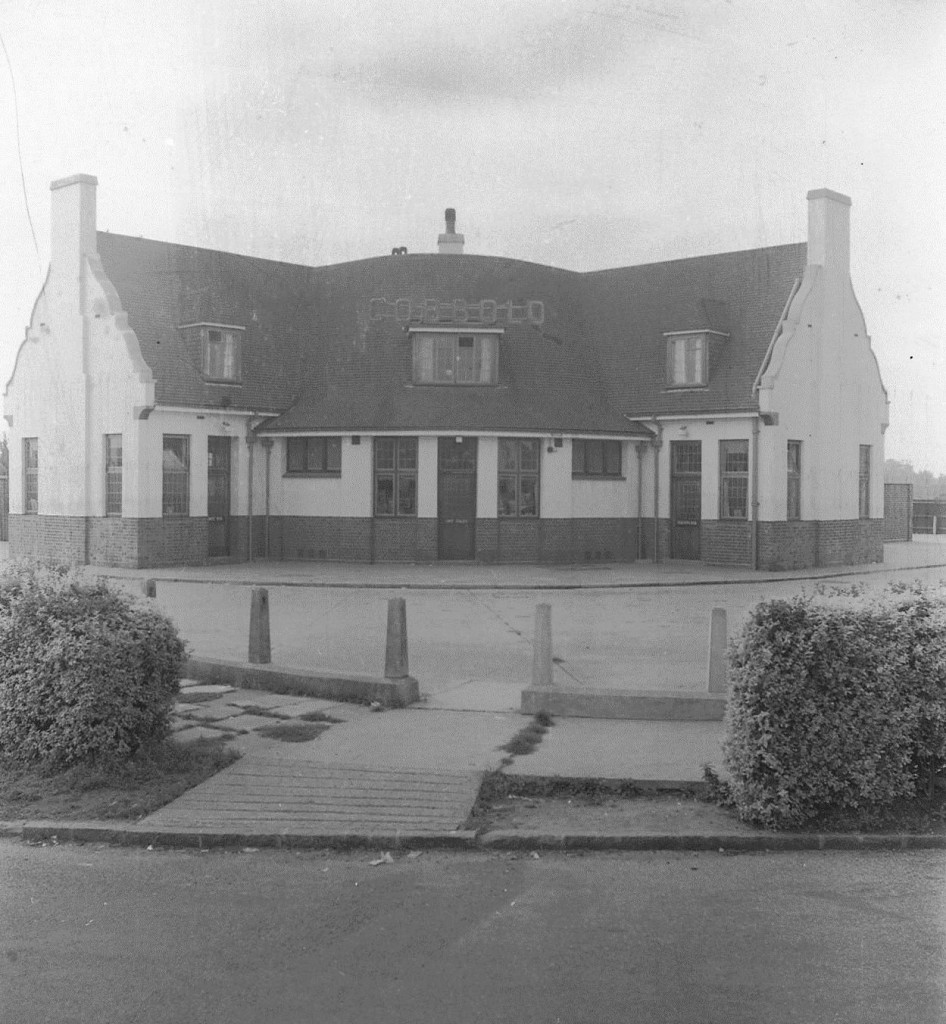
Devonshire Arms
The Devonshire Arms – delightfully situated at the junction of the Ramsey and Oakley roads at Tollgate, Upper Dovercourt, was built in 1937/38 and it opened in April 1938 as the most modern hotel in the area.
Pleasing Design
Of particularly pleasing design, admirably suited to the commanding site it occupies. Dovercourt’s newest and most up-to-date hotel has a red, multicolour brick plinth, with rough-cast finish above. The roof is of hand-made sand-faced tiles.
The accommodation consists of a large public bar with two entrances on the Oakley-road frontage, and is panelled internally in oak. The saloon bar is similar and occupies the Ramsey-road frontage, and here the interior panelling is India silver-grey wood, between these two bars and facing the corner is the off-sales department, also panelled in oak.
On the first floor of the house ample living accommodation is provided for the licensee, and there are also five large bedrooms for the accommodation of guests.
By its very style and position, by the comfort it offers, the hotel is bound to be a popular rendezvous, and added to all this. It has the ideal host & hostess in Mr. and Mrs. A.E. Bye.
Outside, a large area provided parking for 150-200 Cars. There was also a York stone paved garden area and five large heated lock up garages.
Originally Built at a cost of £ 10,000 The pub was renamed the Devon in the new century, in 2012 part of the premises was converted into a convienience store.
GARLAND HOTEL, 65 Garland Road, Parkeston
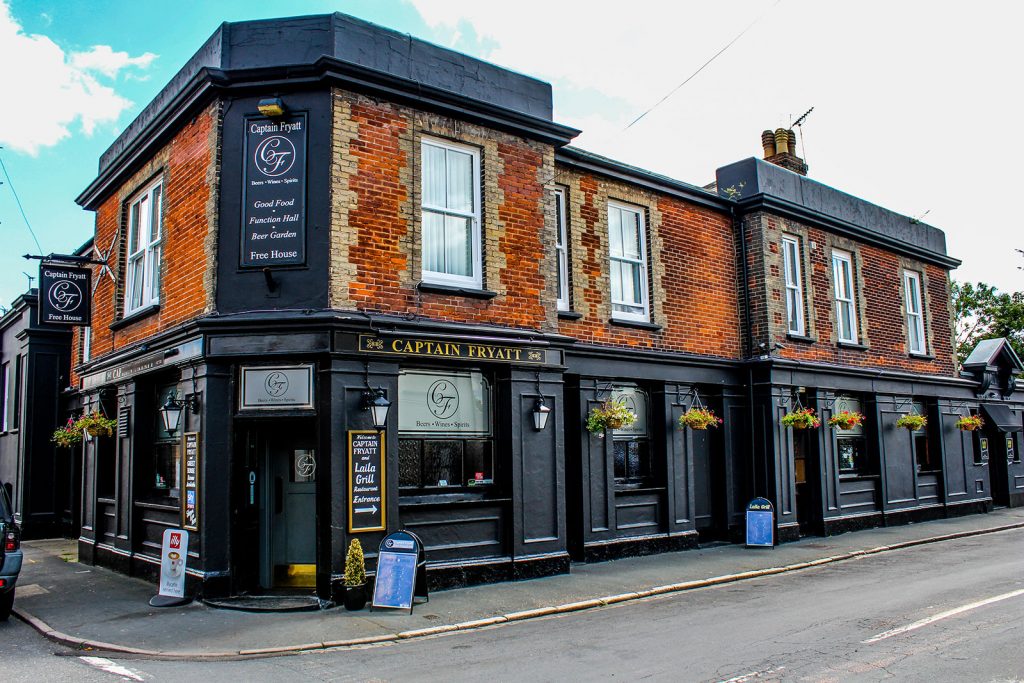
Captain Fryatt
Trading from 1887 as the Garland (Squire Garland who sold land to the Great Eastern Railway to build the Quay and village. The ground floor was a smoking room, with long bar and at the rear a function room. The first floor had ten bedrooms and a dressing room. In 1907 an assembly room and offices were added to the Hotel. The pub was renamed in 1985 after Captain Fryatt, master of the S.S. Brussels. when In 1915 whilst sailing from Parkeston his ship was accosted by a German Submarine near the Maas Lightship.
Fryatt disregarded the signal to stop and steered straight for the submarine which escaped by diving. In 1916, steaming back to England from the Hook of Holland the Brussels was captured by a torpedo-boat flotilla and taken to Zeebrugge. Fryatt was tried by the Germans for his action and shot the same day.
KING’S ARMS, 178 High Street, Dovercourt
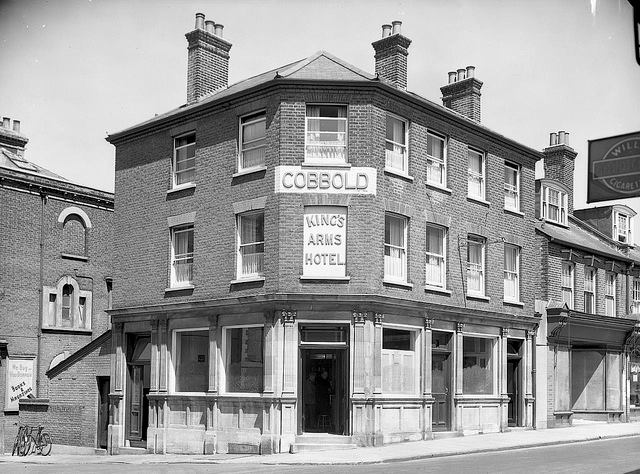
King’s Arms
Built as a private residence as part of Bagshaw’s development. The King’s Arms was trading as a coaching inn in 1753, when it was owned by Cobbold, and was a copyhold public house. The Kings Arms was sold in 1837 as part of the Harwich Brewery in parallel to the main Cobbold operation at Ipswich. The auction was at the White Hart in Harwich and describes the extent of the property which contained a Parlour, Bar and Bar-parlour, Tap Room, Club Room over end of Malting; three Bed Rooms, Cellar and Wash-house underground, and Soldiers’ Room under Tap Room.
A capital three-stalled Stable with Loft over, standing for six Horses, Piggeries, lean-to Coal-house, with Chamber over Shed, Yard, and Garden.
The pub contained a Springwell, with barley and malt chambers, that supplied the Harwich Brewery. It was converted into a hotel in 1864, and is still trading today.
In 2016 Real ale enthusiasts launched a bid to see the pub listed as an asset of community value. If it gets the status, residents will be given six months to bid for it should the pub be put up for sale, stop its change of use or prevent it being demolished.
QUEEN’S HOTEL, 119 High Street, Dovercourt
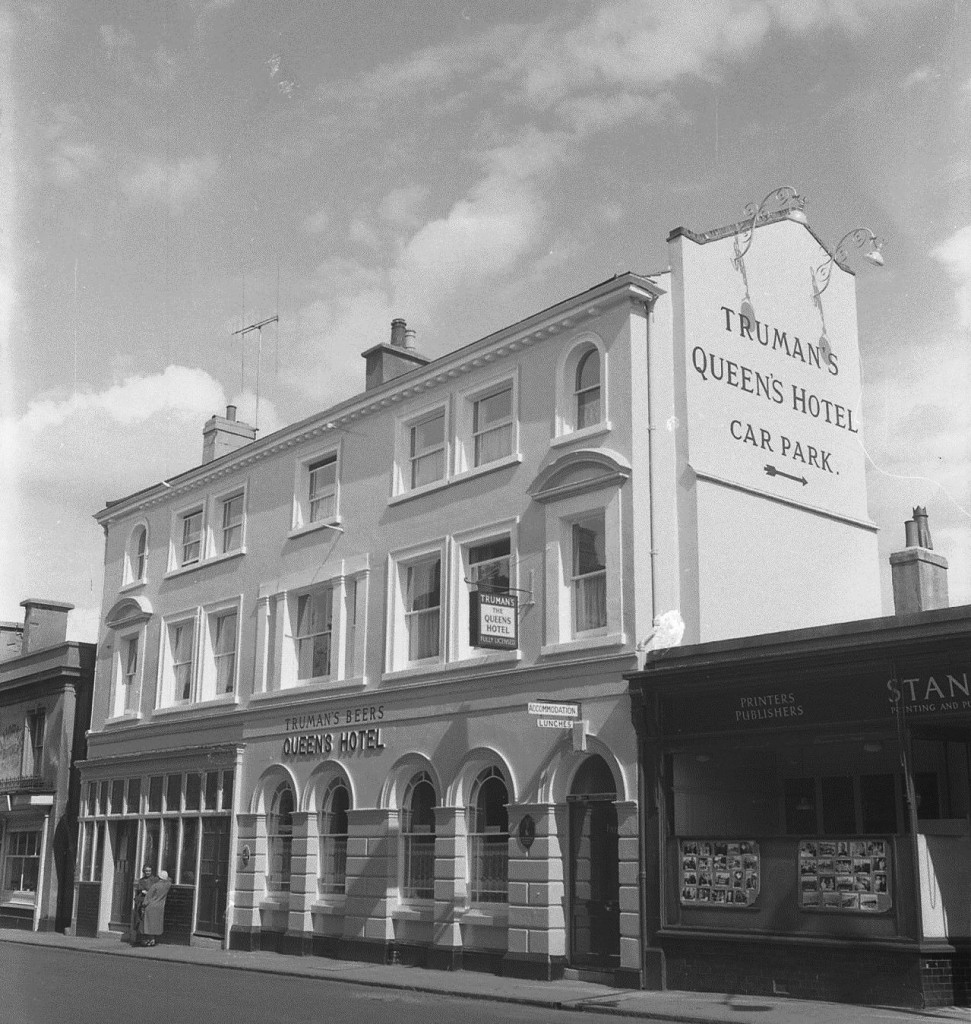
Queens Hotel
Trading from 1856 and known as the Queen’s Head Inn. It was a family and commercial hotel owned from 1873 until 1910 by Robert Bagshaw.
Fire:
The blaze broke out in the derelict Queens Hotel, shortly before 3am on the 25th August 2011. The fire spread to the first and second floors of the three-storey building, which dates from the 1850’s. Crews from Dovercourt, Manningtree, Weeley, Clacton and Colchester helped battle the flames. A spokesman for Essex County Fire and Rescue Service said the building is derelict and there was no one inside. The Hotel was demolished later that year.
PHOENIX HOTEL, Lower Marine Parade, Dovercourt
Built in 1869 replacing the premises of the same name. The Phoenix was completely destroyed by fire shortly after midnight on Thursday morning 28th May 1914. The hotel was well-known to thousands of visitors to Dovercourt during the summer, and was also known as the comfortable residence of many visitors. The Phoenix was almost entirely a wooden building; In fact there was only one brick wall, so it was not surprising that the work and construction was very rapid. The new building was much larger and on the ground floor was a bar open to the public, with a dining room, and dance floor.
In 1985 the hotel was modernised and the ballroom/dining room converted into a nightclub ‘Reflections’. Sadly this closed in 2003.
ROYAL, 387 Main Road, Dovercourt
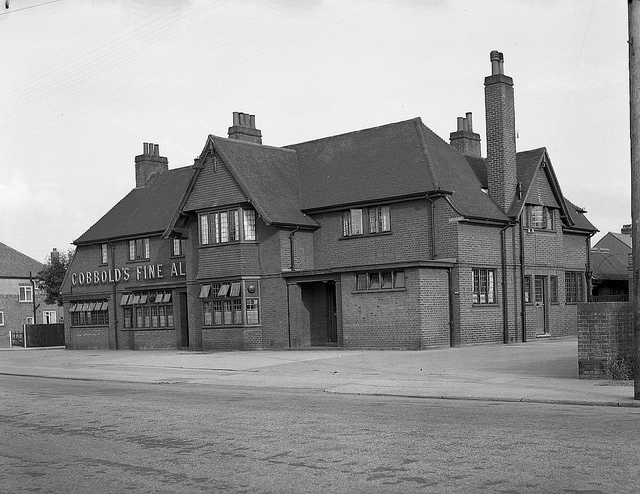
The Royal
Built as a replacement for the Royal Hotel in Harwich. In 1933 it became the headquarters of the Harwich & Dovercourt Homing Pigeon Society and Harwich Rangers FC. Popular Landlord Bill Chambers, who died in 2004, held the pub for many years until his retirement in 1983. The focal point for the residents of Manor Road was the local pub, situated on Main Road between Manor Road and Kings Road. It boasted a public bar, a saloon bar, several large reception rooms and little off licence known as either the “Jug or Bottle” or more commonly known as “The Snug”.
Despite its small intimate size – it became a favourite place to sit and enjoy a quick drink and a smoke with favoured friends.
2020 – Last orders to be called.
Plans have been unveiled for The Royal to be demolished and 14 flats built in its place.
Tendring Council, said the pub has experienced an extended period of declining trade and the applicant made the decision to conclude trading earlier this year.
ROYAL OAK, 226 Main Road, Dovercourt
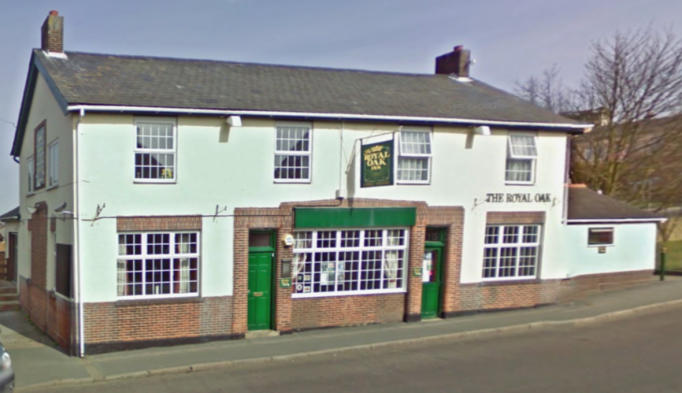
Royal Oak
The Royal Oak, which gave its name to the Royal Oak football ground opposite and is home of Harwich and Parkeston FC. Trading from 1873 as an alehouse owned by Astons the brewers of Manningtree and later became a Daniels, the Truman’s house. The pub suffered a fire and was rebuilt by local builders H.H. Bradford. The Royal Oak is still trading today and is well known locally for its good food.
THE TOWERS, Main Road, Dovercourt
A well-known landmark is the Tower, now operating successfully as a hotel. Built in the mid-1880s for local cement entrepreneur J R Patrick. The building and grounds then began years of service to education. Ernest Montague Jackson moved from Sevenoaks in 1907 and established a prep school for boys in the Tower, offering spacious and tall rooms, classically decorated and far removed from the school rooms of today.The building was re-purchased in 1982 and converted to a hotel. The Towers are still open today.
TRAFALGAR INN, 616 Main Road, Upper Dovercourt
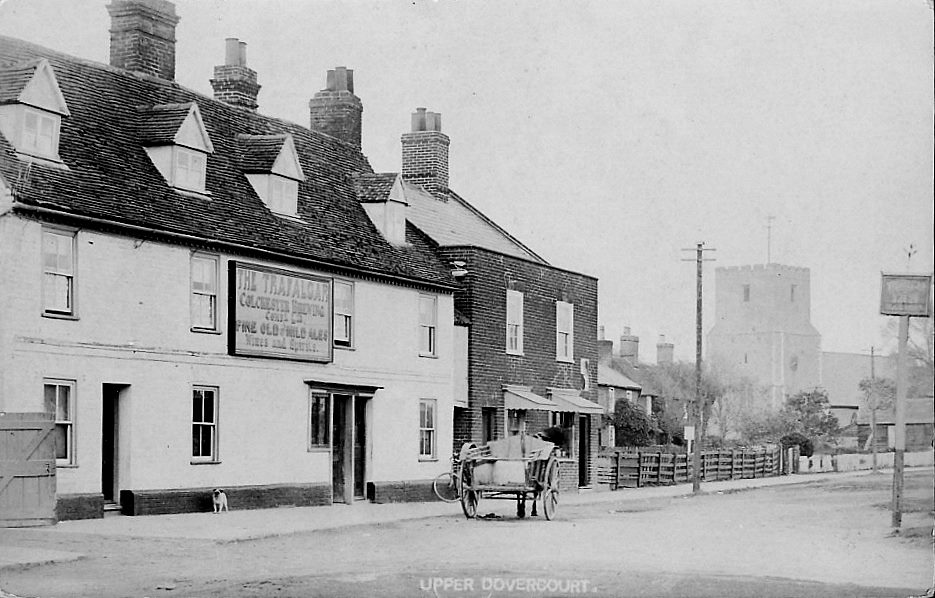
The Trafalgar
On the High Road (as it was known) on the Green stands the Trafalgar Inn, a fourteenth century coaching inn, the original building is believed to have been destroyed by fire at the time of the battle of Trafalgar. It is thought that the pub was converted from a row of cottages that once stood there. The ‘Traf’ was purchased in 2001 by Ridley’s the brewers, and remains the popular pub it has been over many years. It became an asset of community value on 3rd February 2015.
VICTORIA HOTEL, 20 Station Road, Dovercourt
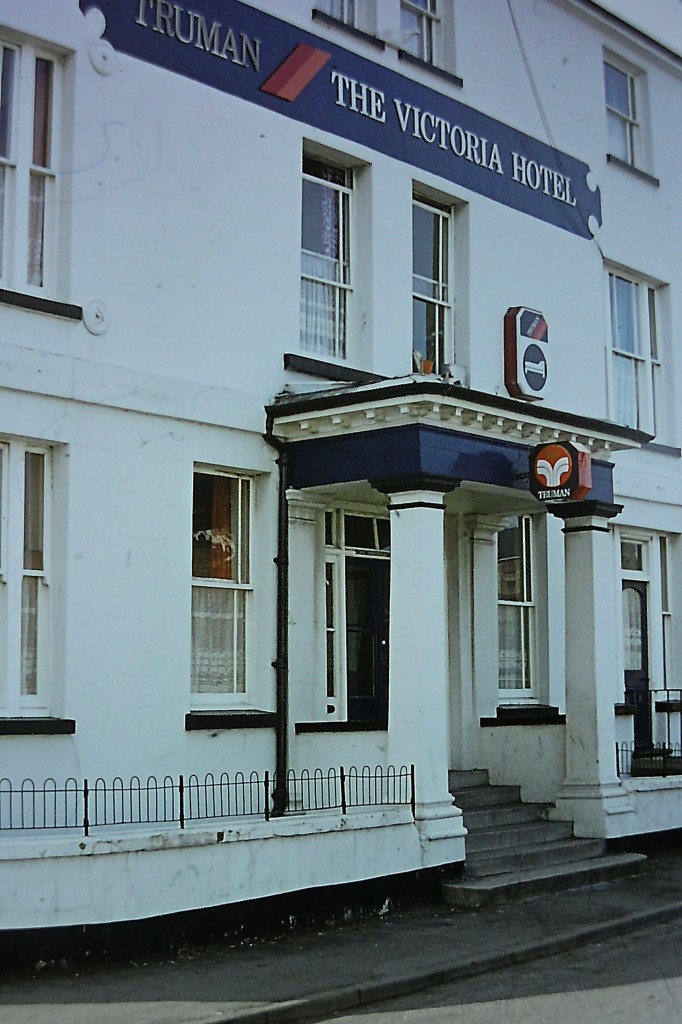
Victoria Hotel
Trading from 1861. A popular pub with railway workers from Parkeston Quay who would have their pints ready for them on the bar as soon as the train departed from the quay. Fire. Police and fire crews were combing the Victoria Hotel in Harwich on the 25th June 2005 for clues as to what sparked the fire which started at around 1.45am. Neighbours who were evacuated from their homes in Victoria Street said they were awoken by the sound of fireworks minutes before the fire. Fire fighters spent more than four hours tackling the flames which spread quickly from a downstairs room to the top of the building. At one stage the 1861 pub was in danger of collapsing, forcing firefighters from Dovercourt, Colchester and Manningtree to retreat. No one was inside the pub which was locked up for the night which lately had been open only rarely. Senior fire officers said they were treating the blaze as suspicious. The Hotel has since been demolished.
Photo by Dean Whattler.
WHITE HORSE, 489 Main Road, Upper Dovercourt
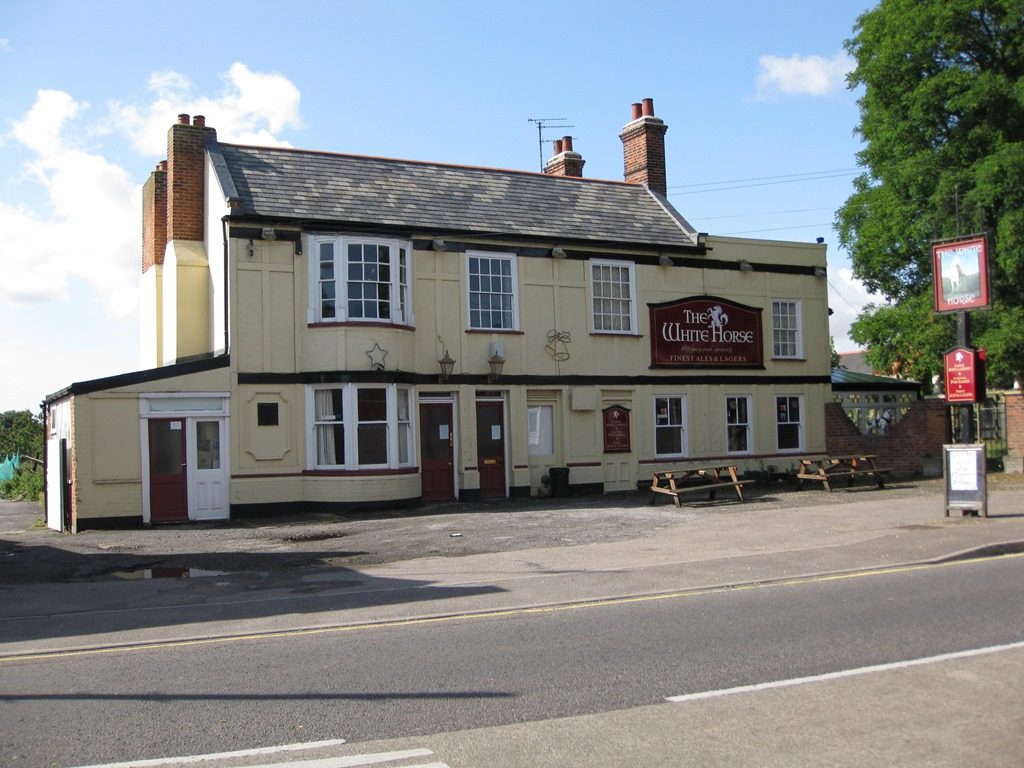
White Horse
The White Horse was previously known as the George. It was built on land owned by the Guild of St George, renamed the Great White Horse and was given the name the White Horse in the 1870s. In May 1817 mock elections that followed the official chairing of the Harwich mayor, were held at Dovercourt and it was the occasion for popular festivities. The chairing took place before an immense crowd who had been attracted by the two previous days of amusing sports arranged by Mr Wylie of the White Horse. The White Horse is now residential housing named William Bleakley Mews which opened in March 2012.
A combination of the smoking ban, cheap alcohol in supermarkets and the economic downturn have been widely blamed for leaving publicans in many parts of the country struggling to carry on.
Back in the day we used to be taken to the pub by our fathers when we were 18, and he would buy us our first pint, or what he thought was our first pint.
It was a part of our everyday life.
Copyright: We attempted to get the consent of copyright holders to use this material for nearly all of the photographs on the website. In the few cases where names are available, a thorough search was made using telephone directories, photographic copyright directories, People Search and Google Area Search. None of the copyright owners could be traced in this way and we believe we have exhausted all reasonable avenues. The consensus opinion of these authorities was that if any two of the following situations applied we would be deemed to have taken sufficient action to avoid infringing copyright laws: No financial gain will be made in relation to the photos. The website owner undertakes to remove any photograph from the website where offence is caused. All the above conditions have therefore been met.
Acknowledgements:
Dean Whattler, Richard Oxborrow, The Harwich Society.
